By: Ivey Schofield
The City of Whiteville just got a boost in its efforts to stimulate economic development downtown through a program that has invested billions of dollars across the state.
By: Ivey Schofield
The City of Whiteville just got a boost in its efforts to stimulate economic development downtown through a program that has invested billions of dollars across the state.
By: Thomas Sherrill, The News Reporter

A student walking onto Southeastern Community College’s campus this fall probably won’t see many changes. But the college will be functioning in a very different way — in a new structure meant to break down bureaucratic silos to better serve students.
Previously the college had two instructional divisions: for-credit curriculum classes and not-for-credit continuing education and workforce development.
The new structure — called the “one-college model” — is meant to bring all instruction and student support under one umbrella, according to Chief Academic Officer Sylvia Cox.
“[Students] can’t put their finger on credit versus non-credit. They just have this goal or mind or this career in mind, so the terms to them are artificial,” said Cox.
“We need to make this a welcoming place to come in the door, out the door, back again, just to say hello,” she said, referring to the reality that community colleges are now called on to help train and retrain workers throughout their careers, not just at the beginning.
“Once a Southeastern Community College student, always a Southeastern Community College student,” said Cox, who was elevated to her executive vice president position following the recent retirements of the vice presidents who oversaw academic affairs and continuing education. The college went from recently having four vice presidents to just two. The other vice president role is filled by Lacie Jacobs, hired in spring 2021 to be chief operating officer. Cox said her experience has prepared her for this new role, previously working as an instructor and overseeing student services. “I feel like I’ve learned so much of the college that it gives me the perspective to pull it together,” Cox explained. “And I know Columbus County, so we’re uniquely designed to serve this county. I always tell people whether you come [to SCC] for an event or you come here for an associate degree, or come here for a class or come here to visit us, we are your community college.”
First of the 58
The idea to shift to the “one-college model” is backed by SCC President Chris English, who helped bridge continuing education and curriculum programs when he worked at the N.C. Community College System office and most recently at Blue Ridge Community College.
“Out of the 58 [community colleges in North Carolina, we’re going to be the first to really implement a one-college model to this extent,” English said.
As an example of the importance of the change, English pointed to how law enforcement training used to be structured at the college. Basic Law Enforcement Training was considered continuing education while criminal justice fell within the curriculum division even though they served students who generally had the same career goals.
“You never knew which hand was talking to the other,” English said.
He gave another example of seeing students in the back twiddling their thumbs in an electrical engineering class and finding out they had already learned the material. But because they had previously taken a continuing education class, they had to take it again for curriculum credit.
English and Cox said that the one-college model will better enable SCC to offer “stackable credentials” — a term for educational programs that build on one another and improve the employability of students even if they don’t complete an entire degree program.
The college’s new structure will also ensure that every student — not just those in traditional academic programs — receives advising and other support services.
“We can’t just look at providing instruction for students. Having an open door is one thing, but if we want students to be successful, we have to do way more than open the door. We have to open the door and provide the support they need,” Cox said.
Implementation
Many of the changes brought about by the new model won’t be felt by students but rather by employees.
“There’s going to be a lot of cross-training,” English said.
Cox and English have met with most of the faculty already to explain the new model, and both said the meetings were productive with instructors from both sides realizing the resources that each side can bring.
English said that, on an instructor level, he feels it allows them more flexibility.
“They’re in control of that to meet business and industry needs or to meet new student needs,” English explained.
Cox and English said that six deans are now in place of the former department head positions.
“When we restructured, we didn’t eliminate jobs; we elevated people to the next level whether it be through a dean position, or a program specialist or an associate dean position that aligned their skill set and their knowledge within that department,” English said.
English said he will know the restructuring is successful if the college increases the number of credentials its students earn. He is confident that the model will grow enrollment in the college and, in turn, grow its funding. “We’re going to be able to offer more in areas we haven’t seen in the past,” English predicted.

A rendering of the International Commerce Center, a spec building under construction by Cameron Management Company in the International Logistics Park of North Carolina, an industrial park that overlaps the Columbus-Brunswick County line.
By: Thomas Sherrill, The News Reporte
An industrial park that overlaps the Brunswick-Columbus county line on U.S. 74-76 will have its first tenant — a high-precision component parts company that will invest more than $9.3 million, Gov. Roy Cooper announced Tuesday.
Precision Swiss Products, Inc. will locate its headquarters and manufacturing facility in the International Logistics Park by the end of the year, according to the announcement. The company will be on the Brunswick County side of the park, but Columbus County will share in the property tax proceeds because of an agreement between the two counties.
Columbus County Economic Development Director Gary Lanier said Tuesday that, while the negotiations were mainly between Precision and economic developers in Brunswick County, Columbus should benefit from the company’s relocation.
“Our friends in Brunswick Industrial Development have been working with this company for well over a year,” Lanier said. “We knew it was getting close to working out.”
According to Cooper’s statement, “Precision Swiss Products is a major producer of small, high precision parts for the aerospace, medical device and semiconductor industries. Made of microscopic metal and plastic, PSP’s parts are used in heart valves, implantables, braking systems, throttles and chamber components.”
“This will be a key first company to go into the park, the first, I hope, of many to follow,” Lanier said.
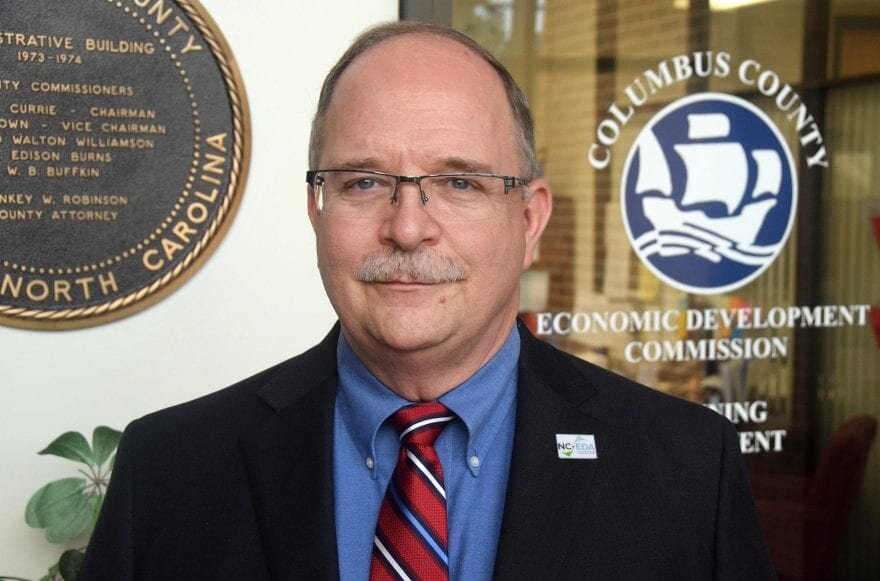
Gary Lanier, Columbus County Economic Development Director
“I think it shows the potential of the International Logistics Park and the private industrial park across the street,” said Columbus Jobs Foundation Chair Les High, referring to the Mid-Atlantic Industrial Rail Park, located on the north side of U.S. 74-76 in Brunswick County. “The partnership we have with Brunswick County benefits both in a number of ways, but notably it has the potential to create large-scale employment for both counties.” High is also publisher of The News Reporter.
The agreement with Precision happened in part because Columbus and Brunswick counties finished a “big push,” as Lanier called it, to get water and sewer inter-local agreements signed off by each county’s commissioners.
Lanier said that Precision will move into a 60,000-square-foot building that Cameron Management Group of Wilmington constructed on spec and marketed as the International Commerce Center. The building is under construction with a tentative finish date of November.
“They’re pouring the footings this week,” Lanier said, noting that it took 12–18 months to get steel for the building.
Cooper’s statement says that Precision’s average annual salary for all new positions is $54,025, well above the Columbus County average wage of $35,138.
“The North Carolina Department of Commerce led the state’s efforts to support PSP’s decision to locate to North Carolina. The new jobs will employ highly skilled machinists, shipping and receiving workers, quality control personnel, executive and administrative staff,” Cooper’s statement said.

Columbus County government extended water lines to the International Logistics Park on U.S. 74-76 at the Columbus-Brunswick County line. Photo by Diana Matthews
Lanier said Precision could be a landing point for graduates of Southeastern Community College, specifically in mechatronics, electrical engineering and other such programs.
“These are not entry-level jobs; these are high-tech, high paying manufacturing jobs,” Lanier said.
Lanier thanked the Columbus County Board of Commissioners and County Manager Eddie Madden for their support, explaining that he gave them updates during closed sessions in recent months.
“It’s very clear to me they are focused on doing whatever is necessary to attract good quality jobs like these,” Lanier said.
As far as incentives, Lanier said most of them come from the Brunswick side of the agreement and he couldn’t speak on them, explaining that the state-level incentives were more important. Lanier said that soon an incentive package will go in front of the Columbus County Commissioners after it is approved first by the Brunswick County Commissioners.
Cooper’s statement said the expansion is facilitated in part by a Job Development Investment Grant approved by the state’s Economic Investment Committee earlier Tuesday.
“Over the course of the 10-year term of the grant, the project is estimated to grow the state’s economy by more than $301 million. Using a formula that takes into account the new tax revenues generated by the 125 new jobs, the JDIG agreement authorizes the potential reimbursement to the company of up to $1,779,000 spread over 10 years,” the governor’s statement explained.
Columbus County’s Tier 1 economic distress ranking means that the Job Development Investment Grant precludes Precision from making a contribution into the state’s Industrial Development Fund – Utility Account.
Editor’s note. This is the third of a three-part series on the Lumber River and its potential as an eco-tourism destination.
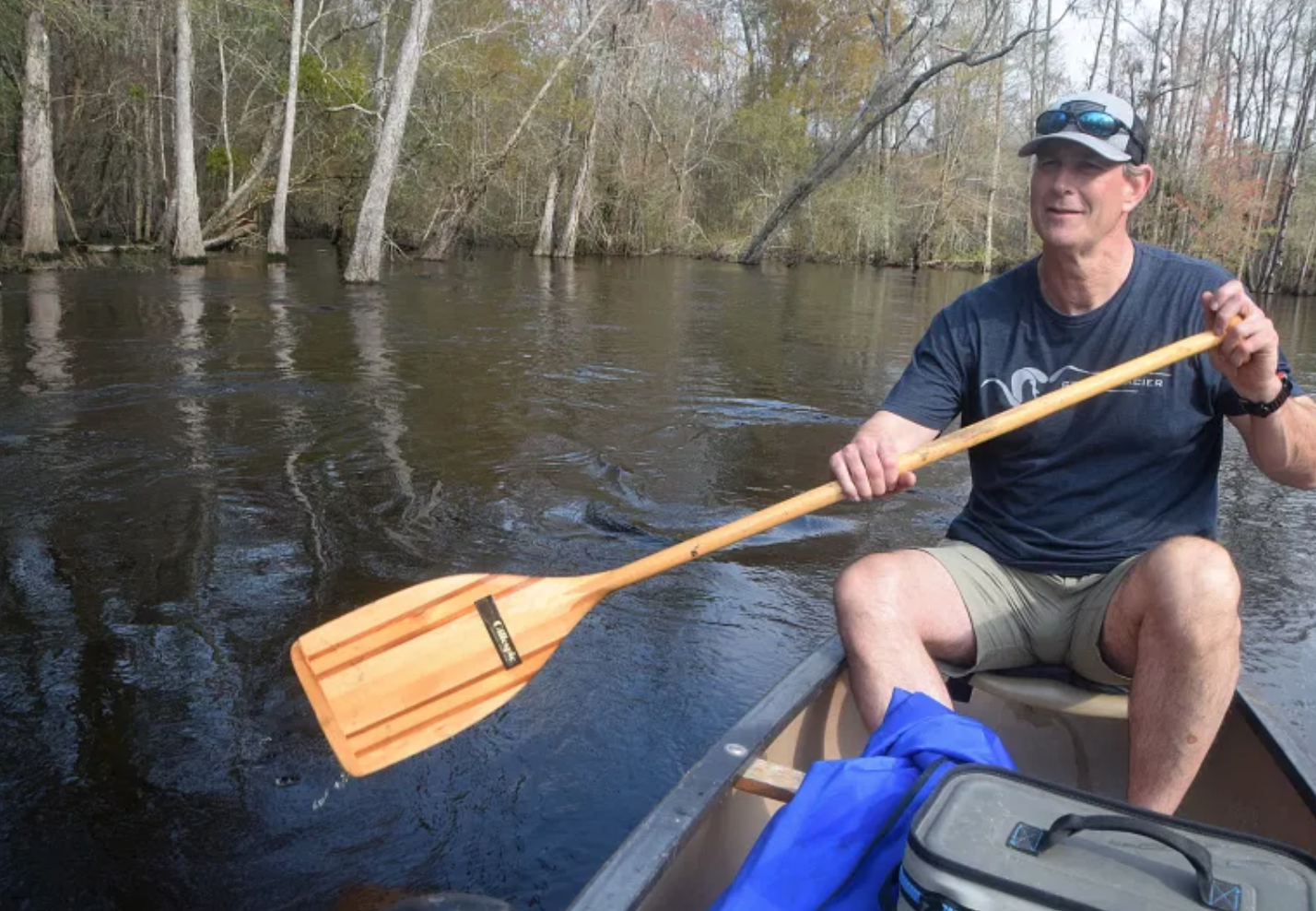
Dickson McLean is a long-time paddler on the river and a member of the Lumber River Conservancy board. Photos by Les High
Even though the Lumber River is one of only five rivers in North Carolina designated as “Wild and Scenic” by Congress, the meandering waterway sees limited use except for locals who were raised on it.
The Lumber River runs 115 miles from its headwaters at Drowning Creek near Southern Pines to the South Carolina line, where it merges with the Little Pee Dee River near Nichols, S.C. Eighty-one miles of the river are designated as Wild and Scenic. Like many coastal rivers, little of it runs in a straight line; instead, the river is one switchback after another.
It’s a tannin-stained river with a rich, dark-brown tone; yet, the color of the water belies how clean it is thanks in part to its mostly sandy bottom and limited development along its corridor.
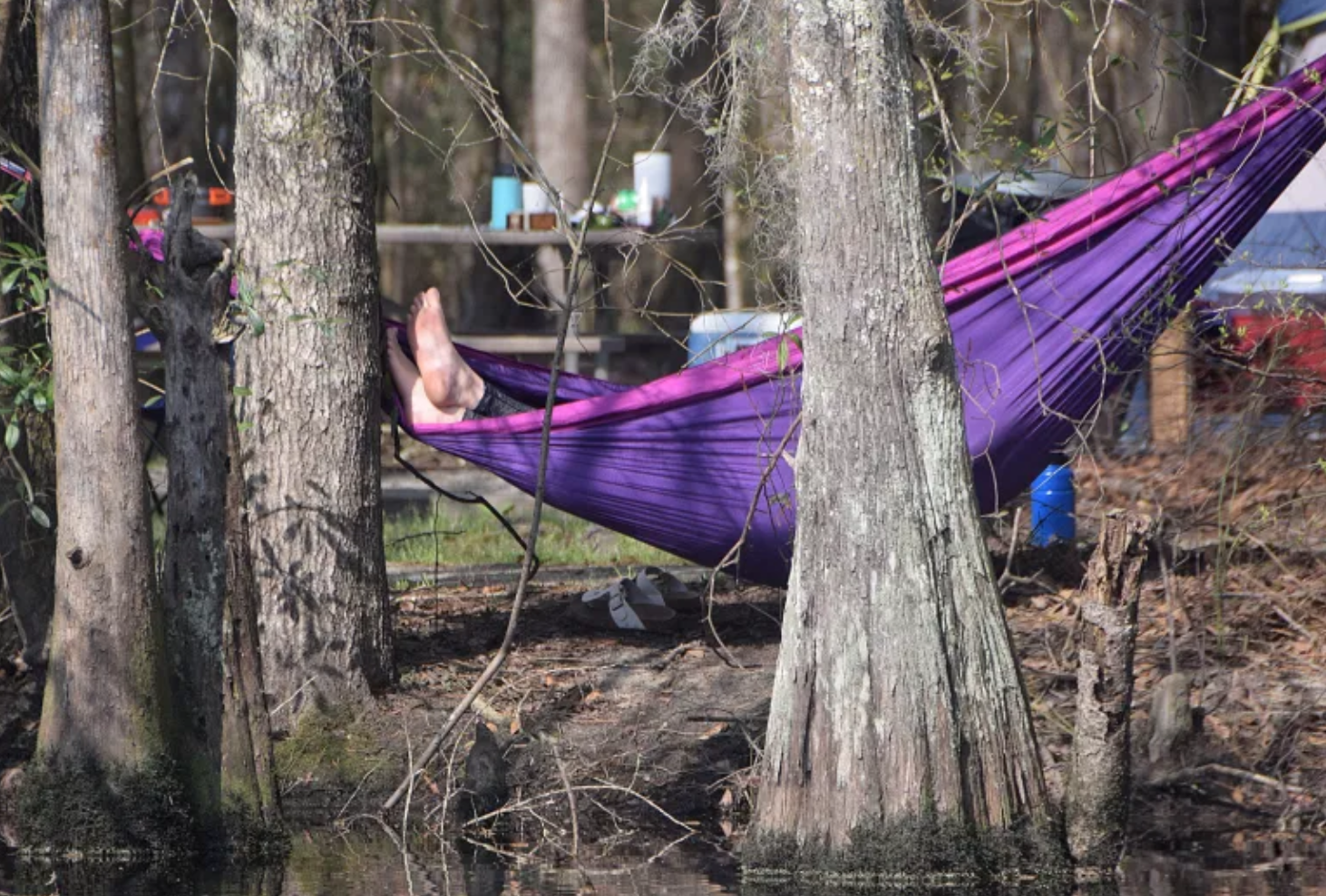
An easy morning at the Lumber River State Park campsite at Orrum.
Almost 18,000 acres that adjoin the river are owned or preserved by the State of North Carolina and the Lumber River Conservancy, a non-profit group founded by the late Lumberton businessman Carr Gibson and the late attorney Dickson McLean III. About 4,000 acres are attributed to the volunteer group’s efforts. The Lumber River Conservancy, founded in 1991, is one of the oldest in North Carolina.
The Lumber River State Park adjoins the river in several sections. There is a campground, a boat launch and a picnic area at Chalk Banks near Wagram in Scotland County. The river then runs through the ancient tribal grounds of the Lumbee Tribe near Pembroke, under I-95 at Lumberton, on to Boardman at U.S. 74, then forms the border between Columbus and Robeson counties until it reaches the state line. The Lumber River State Park’s headquarters are at Princess Ann Landing near Orrum in Robeson County, not far from U.S. 74.
An easy float down river
Princess Ann Landing is where I met Dickson McLean IV, a Wilmington attorney who plays a leading role in the Lumber River Conservancy; Joseph White, the conservancy’s director and a professor of biology at UNC Pembroke; Lumber River State Park Superintendent Lane Garner, and Park Ranger Zachary Lunn.
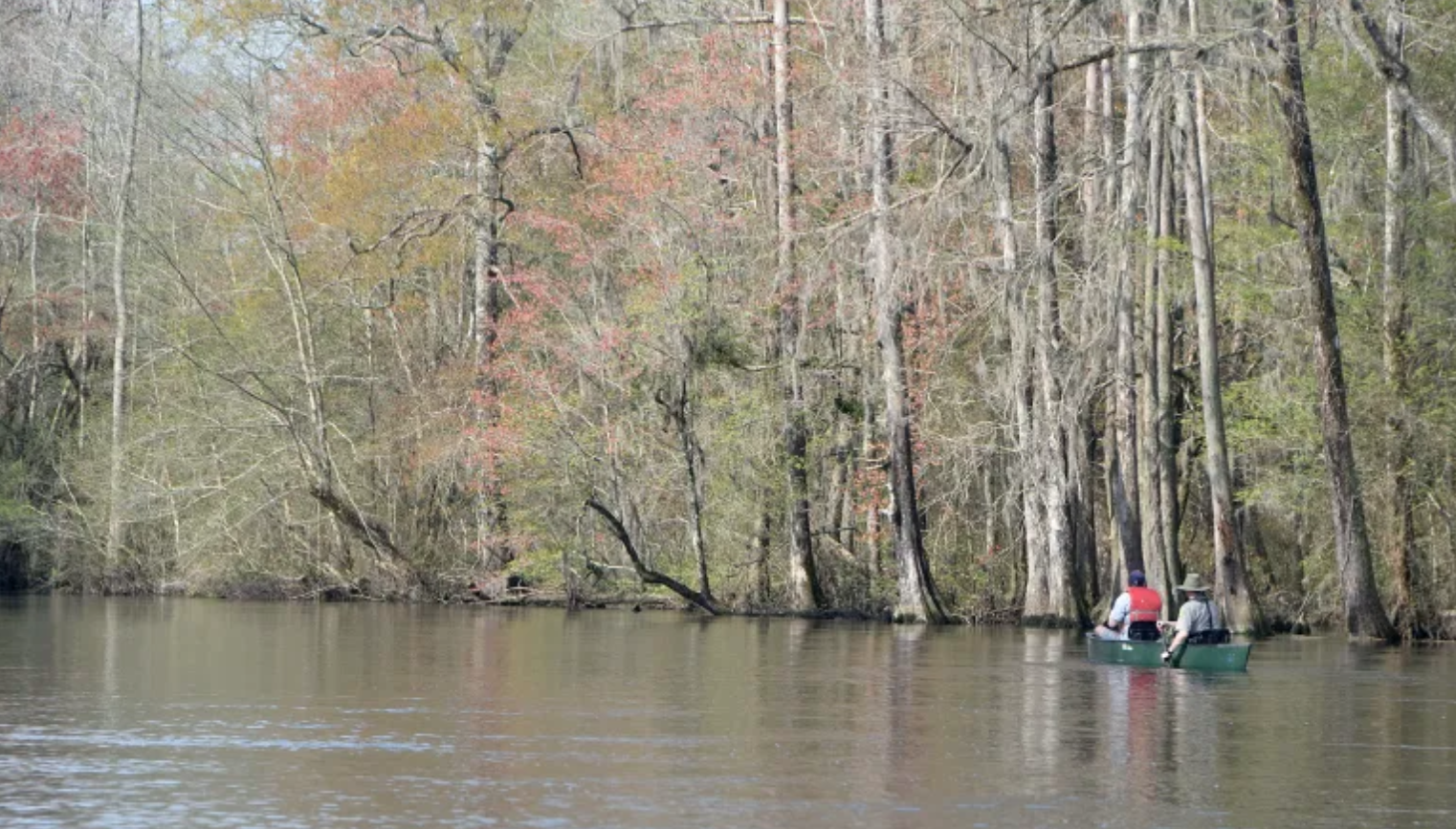
UNC Pembroke Biologist and Lumber River Conservancy Director Joseph White with Park Ranger Zachary Lunn
On this day, March 27, a group of four dads and their sons from Trail Life troop 1533 in the Raleigh-Durham area spent the night at the Princess Ann Landing campsite and are ready for a day of paddling.
It reminds McLean of his time as a boy when he and his father, his brother Robert and friend Neil Lee, who later become park superintendent, would take five-day canoe trips as Sea Scouts from Lumberton to Georgetown, S.C., the terminus of the Lumber, Waccamaw, Little Pee Dee and Pee Dee rivers at Winyah Bay.
At dusk, they would look for sandbars on which to pitch tents and camp.
McLean remembers waking up one night to the sound of lapping water, and later feeling a sensation of wetness creeping into his sleeping bag. Little did the group know that they were close enough to the ocean to experience tides. To make matters worse, two of the three canoes had floated away. Dickson and Robert grabbed flashlights, and by some miracle, found one canoe downstream, then the other one.

Preparing to launch from the Orrum boat landing.
•••
The river had a steady flow from heavy rains earlier in the spring and winter. A week ago, the river would have been dangerous to paddle, Garner says.
“It still flows like it did a thousand years ago,” he adds.
Paddlers should always call ahead for river conditions, Garner cautions.
The park staff has the occasional call for lost paddlers and drownings. The river is mostly free of downed trees, thanks to a North Carolina snagging program that cleared the river after hurricanes Matthew and Florence.
Still, paddlers must be aware of underwater hazards and be careful not to get sidetracked or lost in oxbows, which are old river beds bypassed by the main channel over time.
Garner says the upper part of the river was designated as North Carolina’s first recreational water trail in 1978 and the lower part was designated as a canoe trail in 1981.
“Having the national and state designation of being naturally wild and scenic is pretty awesome,” Garner says. “It’s the only blackwater river in North Carolina that has that designation. This river draws a small number of paddlers who just want to mark this river off their checklist. It also has a rich history and plenty of recreation opportunities. It’s peaceful and beautiful.”
Lumber River history
American Indians are believed to have settled the river about 20,000 years ago. Four hundred and twenty-nine archaeological sites have been recorded in Robeson County, according to the National Wild and Scenic Rivers System website. Early artifacts include a dug-out canoe estimated to be 1,025 years old.
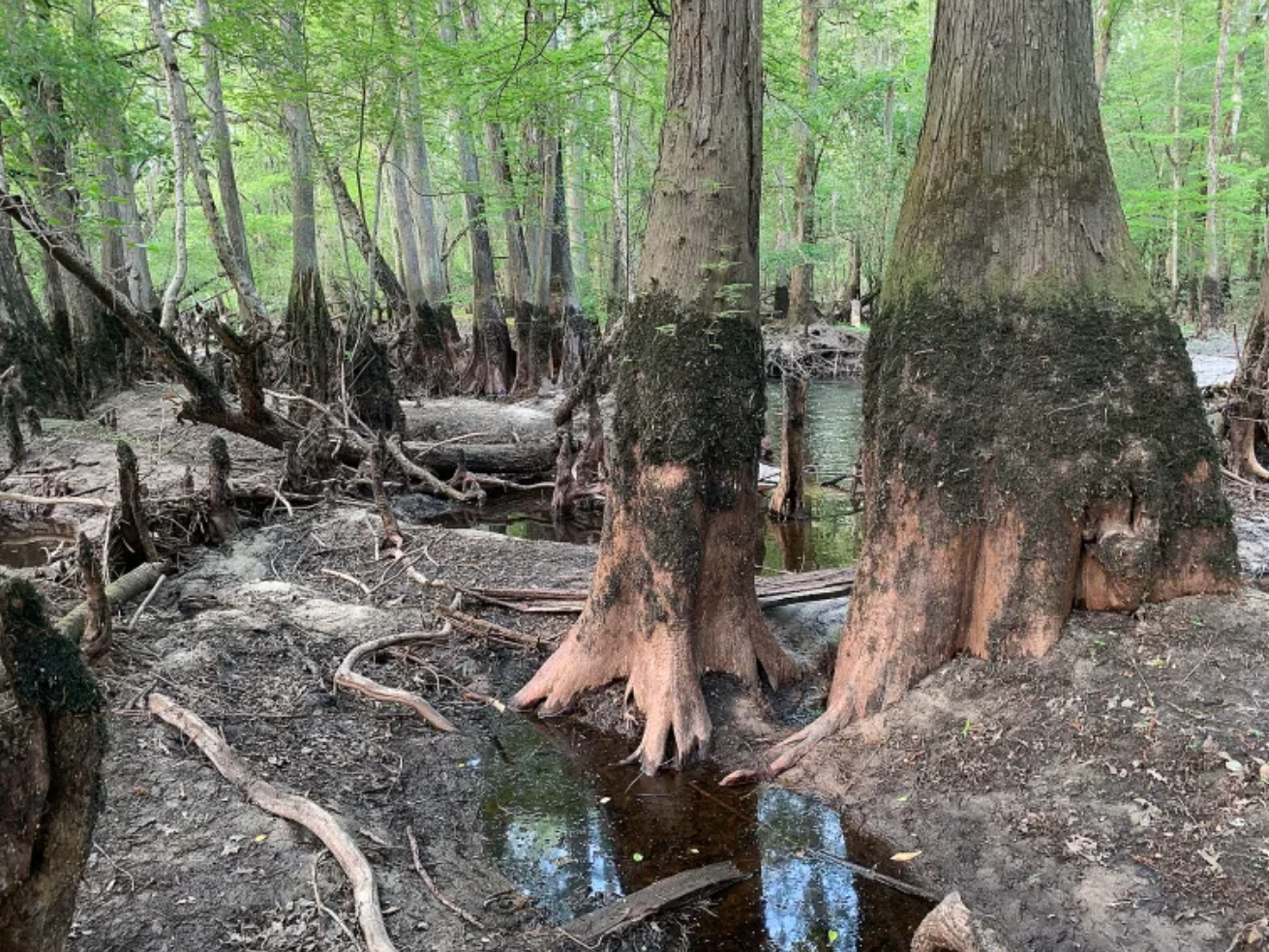
A contrast in water heights.
The river got its name because of extensive logging operations that created a large-scale economy for settlers. In the early days of the nascent timber industry, logs would be floated to Georgetown, a distance of roughly 75 miles. Men who tended the rafts of logs are said to have walked or ridden horses back to the area if the water flow was too strong to paddle against.
Boardman, located on the river where U.S. 74 crosses at the Columbus-Robeson line, was home to the Butters Lumber Company, creating one of the region’s most thriving communities. Logging trams ran throughout the region leading to the lumber mills. The 20-some mile railbed to Fair Bluff is still visible in many sections.
•••
Today’s 11-mile paddle is easy; there’s enough flow to keep the boats moving on their own. The morning coolness gives way to a warmer day with a bit of wind. The trees are just beginning to turn green and a few redbuds and dogwoods are showing some color.
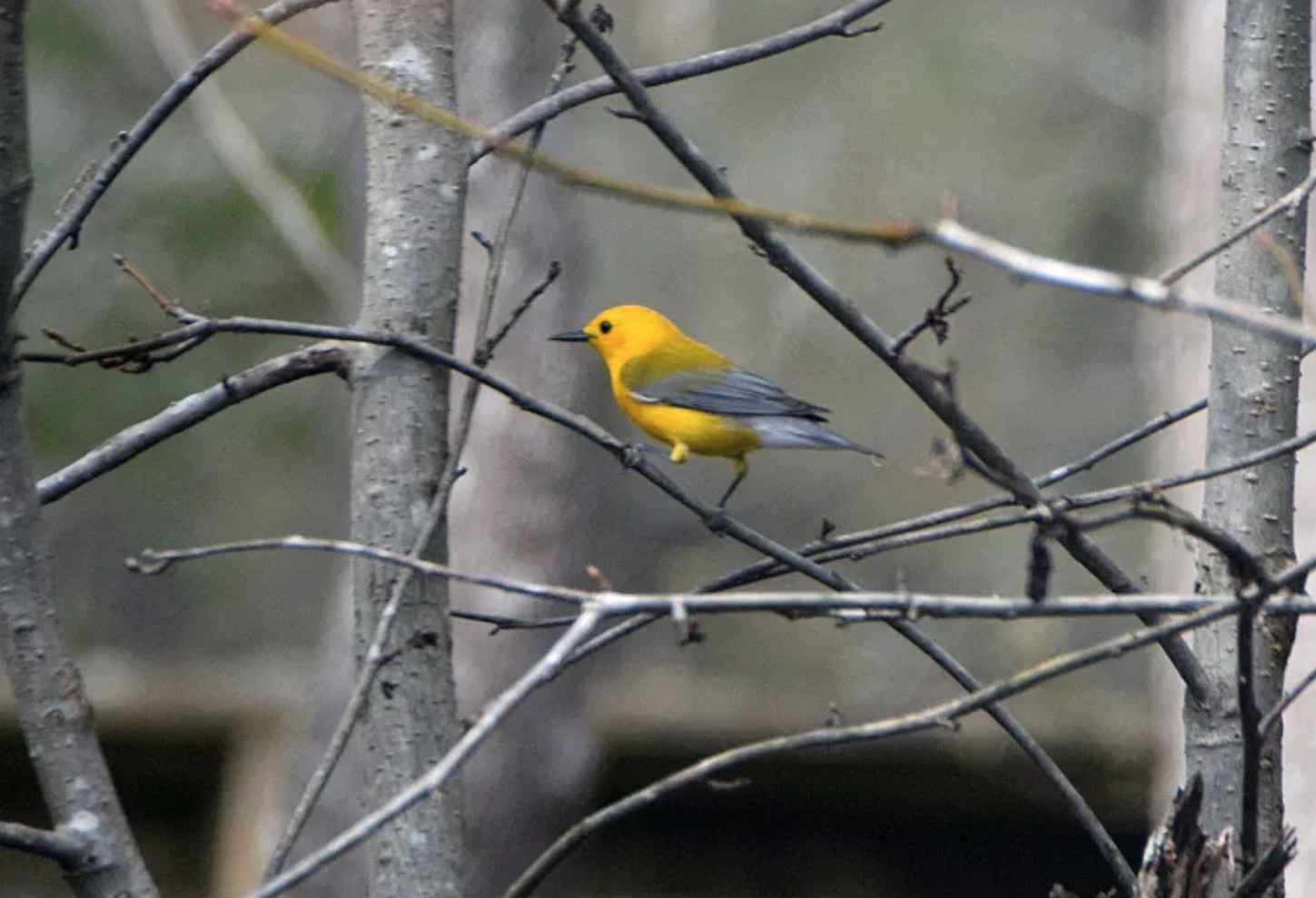
Interesting bird life is common along the river. This is a Prothonotary Warbler.
It’s a quiet paddle except for our talking. We scare the same group of wood ducks off the water a half dozen times. There’s little sign of civilization save for one area where there are a few shacks and an abandoned school bus left to rust long ago. There’s an RV and trailer campground a few miles upstream from Princess Ann off Macedonia Church Road in Columbus County.
Lunch is a couple of hours downriver on a small patch of sandy land owned by the conservancy.
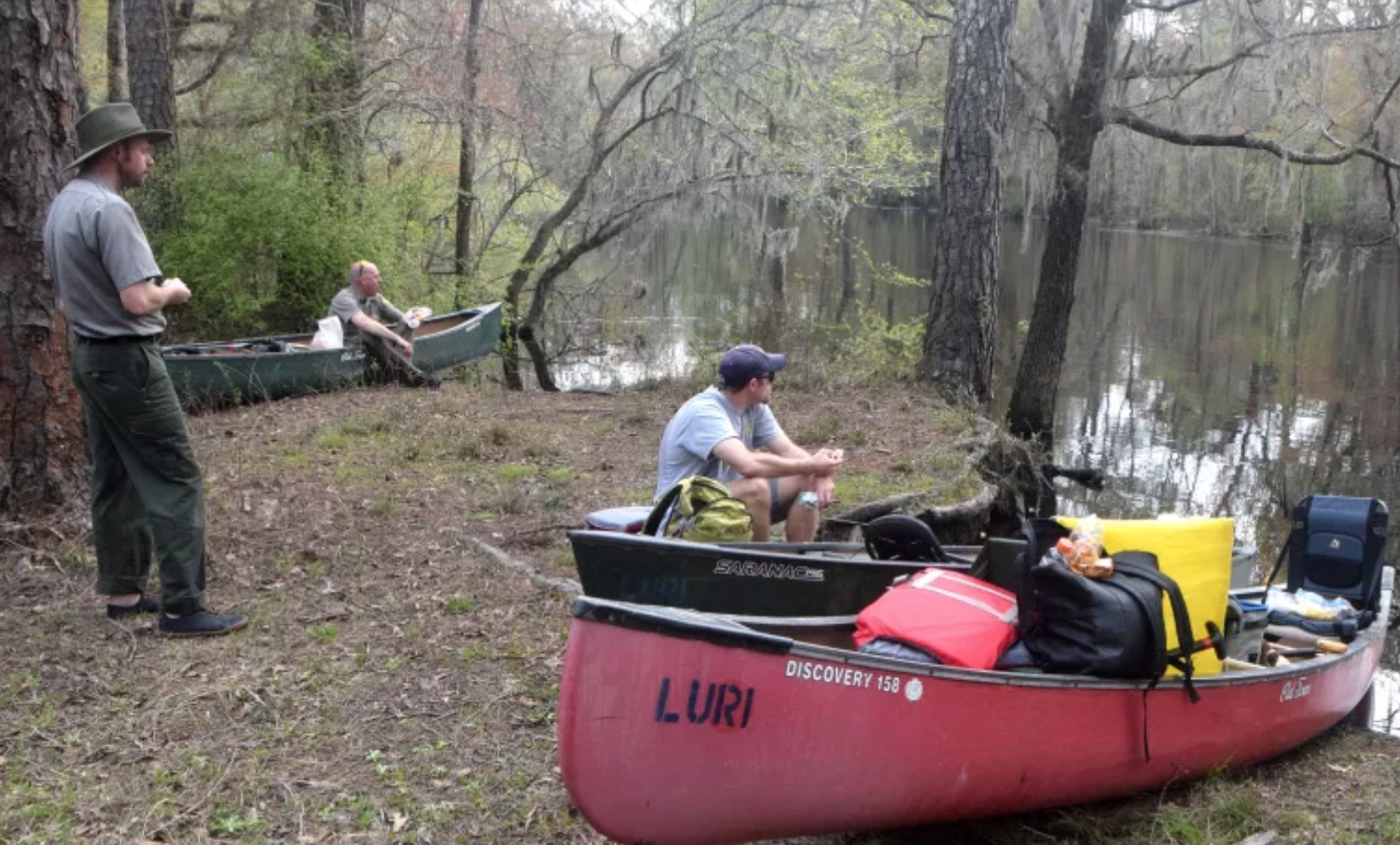
A high piece of land owned by the Conservancy is a good spot to have lunch. Despite spending the morning on the river, it’s hard to take your eyes off of.
Nature calls and we stretch our legs and backs. Lunn asks Garner to demonstrate his ability to call warblers, small birds that are common along the river.
Garner is a “phisher,” which is the art of attracting birds with a repetitive, raspy call. As we eat lunch, Garner impresses our small troupe as he leans back and starts phishing.
Within a matter of seconds, three curious if not slightly agitated warblers are perched in a small tree above him.
Garner, the warbler whisperer, flashes a smile as if to acknowledge that he’s pretty good at this.
The only motorized craft of the day, a jon boat, comes by with three people. They politely slow to minimize the wake, then take off toward Fair Bluff.
We can begin to hear traffic headed to Myrtle Beach on N.C. 904 when a small, dark cloud approaches and the bottom falls out for about 10 minutes. McLean and I don raincoats but the other guys paddle through it. The sun is back out quickly.

Information about the Lumber River Conservancy can be found at lumberriverconservancy.org.
We know we’re near the end of our three-hour paddle when we see the Fair Bluff River Walk. We pull up to the North Carolina Wildlife Commission boat landing in Fair Bluff, dump the water from the canoes, and load them on the carrier that will take them back to Princess Ann for a trip on another day.
Travel times and lengths of Lumber River paddling segments. For more information call 910-628-4564 or email lumber.river@ncparks.gov.

Editor’s note: This is the second of a three-part series that features the Lumber River. Part I covered ecotourism possibilities for Lumber River State Park and Fair Bluff. In this story, Publisher Les High talks with Fair Bluff residents who frequent the river.
For the people of Fair Bluff, love of the Lumber River comes naturally.
The Rev. Ray Lundy, pastor at Fair Bluff Baptist Church from 1979 to 2009, spent many an hour fishing, boating, and camping on the river with his wife, children, and grandchildren. He grew up fishing the Little Pee Dee and Waccamaw rivers with his father near their hometown of Conway, S.C.
“I was a river rat as a kid,” Lundy says. “My father went fishing every week when it was warm. He let me go with him, but only after I learned to swim. He always told me you have to respect the river.”
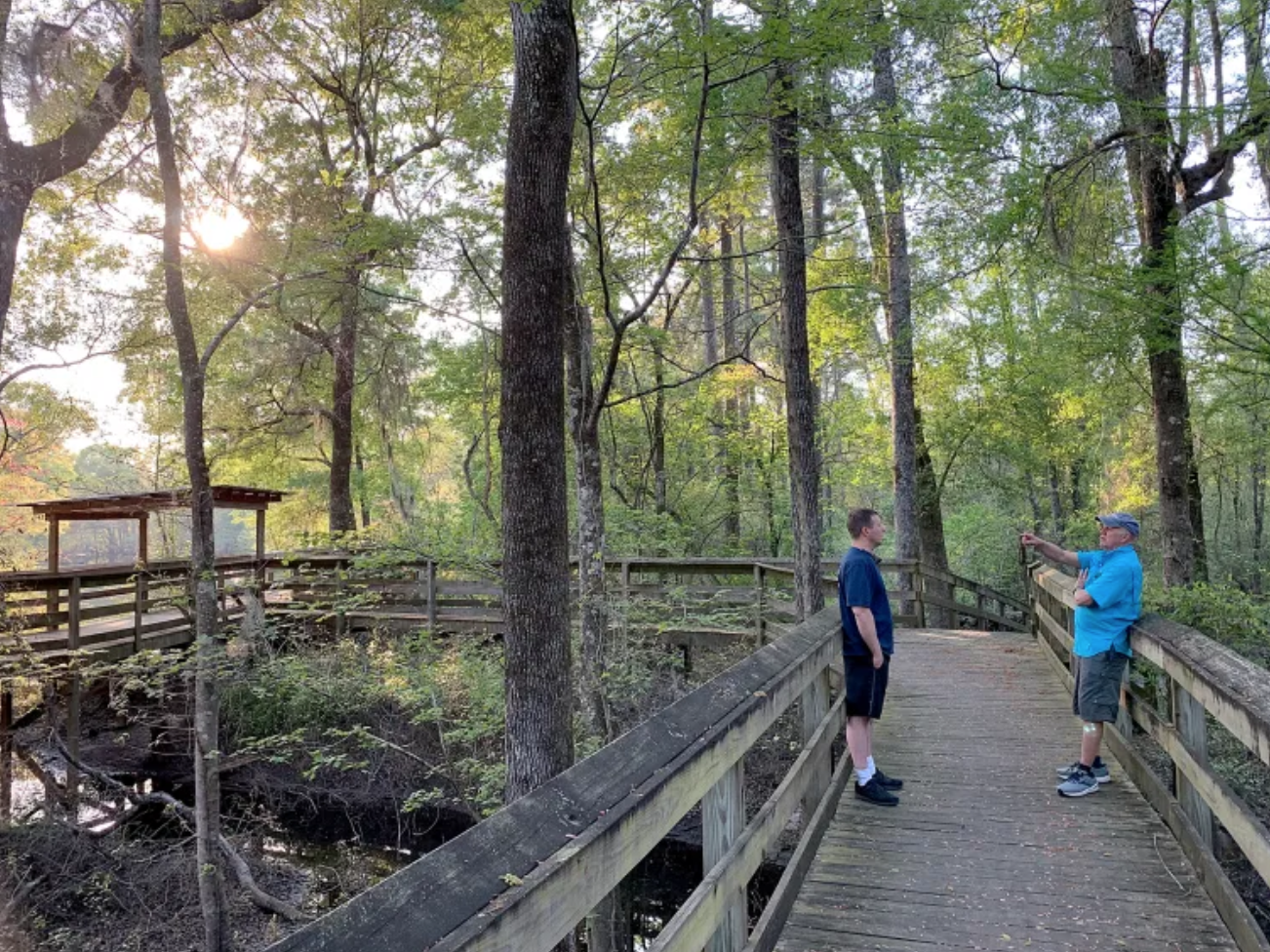
The Rev. Ray Lundy and Todd Bryant share a few moments on the Fair Bluff River Walk, which runs for nearly a mile along the Lumber River. All photos by Les Hig
The town embraced Lundy and his wife Linda when they arrived in Fair Bluff. That meant spending lots of time on the river with friends and parishioners.
He points in the direction of the rope swing and sandy bank where dozens of boys and girls swam in the dark waters. Locals still call it the “Minnie Hole,” named for Minnie Waddell, who fished there often.
Lundy remembers building fires on cold days with his son Jonathan, cleaning ducks in the frigid water. The family often had picnics along the river, and he and Jonathan would take three- to four-day overnight trips, putting up on sandbars to spend the night.
“I remember one day when it was hotter than the hinges of the door on the gates of hell,” Lundy says. “Jonathan told me there was a bad thunderstorm coming, so we hunkered down and it rained like you were pouring water out of a bucket. When it passed through, it was like someone had turned on the air conditioning; it was nice and cool.”
Lundy says he awoke sometime early in the morning to the smell of a wet deer, then heard the unmistakable snort of a bear. A dank, musky odor indicated the bear was close by, probably on the trail of the deer.
When Lundy opened the tent, the bear was nowhere to be seen. He tells the story because it underscores that when it comes to the Lumber River, the wilderness is “right out your back door.”

Lundy says the River Walk and the river offer the kind of peace that’s hard to find in other places.
Time on the river is second nature to people in and around Fair Bluff.
“I think some people are born with it, that wanderlust where you don’t know what’s around the next bend in the river,” Lundy says. “It’s something that’s innate in all of us, and I kinda feel sorry for people who don’t ever get to experience it. I imagine the last thing I’ll have in my head when it’s time to go are the times I had on the river.”
Lundy is naturally affable and gregarious. He enjoys chatting with people on the Fair Bluff River Walk, which meanders for three-quarters of a mile through the cool canopy of cypress and water oaks. He and Linda are on the boardwalk many days, she on foot and he on his recumbent tricycle.
They meet people from all over the East Coast, but locals especially enjoy the meditative powers of the slow-moving water.
Todd Bryant, who lives just across the border in South Carolina, is taking a stroll on the boardwalk on a perfect, sun-drenched late afternoon. Bryant and Lundy begin talking about fishing holes and a three-story tree house that men who fish and hunt on the river assembled in stages over the years.
Lundy shows Bryant the old steam engine rail bed that runs through Red Belly Slough. The tram transported logs from Butters Lumber Company in Boardman to Nichols, S.C., about 30 miles downstream. The old trestle supports barely show above the water.

Luke Robinson with his dog Cooper.
Also on the River Walk, Luke Robinson has taken his dog Cooper, age 9 months, for a walk and a swim. The dog clearly has great affection for Robinson, who says he got Cooper from someone who was going to “throw out the rest of the litter,” presumably by the roadside.
“I’m going to get some ice cream and give Cooper a treat,” he says before disappearing into the fading light around one of the many bends of the boardwalk.
•••
Few people have caught more fish on the lower end of the Lumber River than Willard Small, who turned 96 on April 19. He was a Fair Bluff town commissioner for 48 years and co-owner of Fair Bluff Ford, the local Ford dealership.
“People don’t realize what a good fishing river this is,” Small says. “We’d lock the dealership on Saturdays at 1 p.m. I’d get in my Ford Bronco and head to the river with my strip boat and fish ‘til dark.”
Small would mainly fish for red breast and hard head bream, which are varieties of flatfish.
Small closed the dealership every Fourth of July and a group of men would paddle upriver to wet a line and fry fish on a sandbar. This went on for 20 years or so.
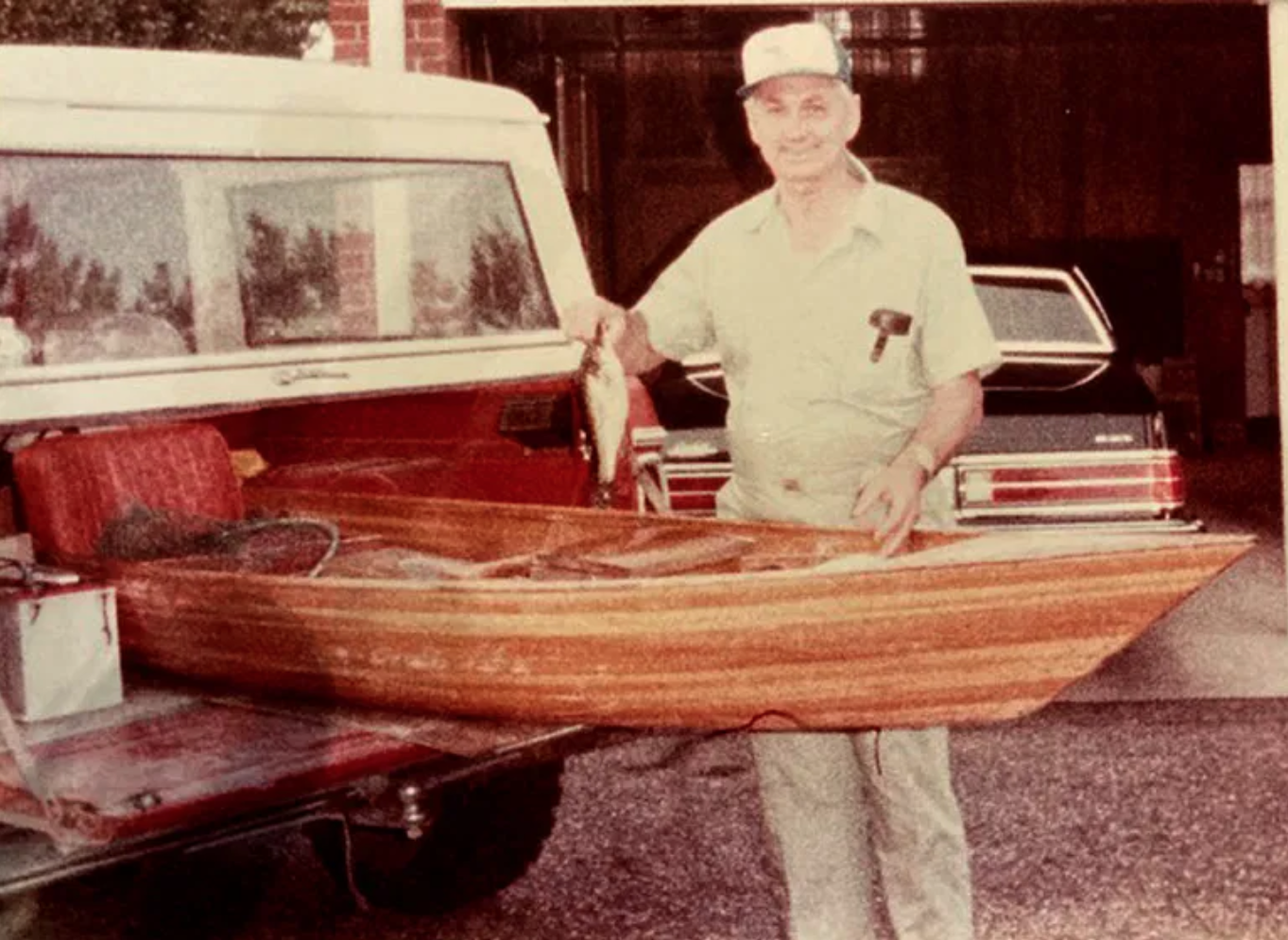
Willard Small, 96, is a life-long fisher of the river who was instrumental in getting the Fair Bluff River Walk funded. Contributed photo
David Small, Willard’s 74-year-old son who worked at the family dealership, says fishing is a way of life on the river, going back generations.
Small recalls the bond fishing created between him and his grandfather Maxcey Small. The younger Small was his grandfather’s designated paddler, “and I inherited my love of the river from him.
“He’d pull up to the house before daylight – around 5:30 – and blow the horn,” Small says. “Nothing interfered with his fishing. He’d even leave the tobacco field if he heard the fish were biting.”
Small says his grandfather knew all the fishing holes and lakes along the river: State Line Lake, Grassy Lake, Deep Lake, Big Hog and Little Hog lakes, among others.
Small’s main task was to paddle, though he occasionally got to fish when the two took a lunch break on a sandbar. That led to a lifetime of fishing with his grandfather and father, and later on his own.
He remembers as a child an area behind Fair Bluff’s business district where the merchants kept about a dozen wooden boats tied up and ready to deploy should word get out that the fish were biting.
“The river and Fair Bluff, they’re one and the same,” Small says.
•••
It seems that everyone who fishes the river has had a traumatic experience with a thunderstorm.
Willard Small was fishing upriver at Deep Lake and heard thunder in the distance. Before he could make it home, it rained and hailed like he’d never seen.
“I had to stop three or four times to empty water out of the boat,” he said. “I’m telling you, I thought I wasn’t going to make it home.
“But, he adds, “one of the best times to catch fish is before and after a storm.”

The leaves of a low-hanging tree in the early-morning light.
As violent as the weather can be, however, Small sees the river and his beloved Fair Bluff River Walk as a place of calm and serenity.
Many locals enjoy the boardwalk daily, and Small was no exception in his younger years. It’s especially pleasant in the early morning or late in the afternoon, when the water meanders among the pilings. Birds, turkey, otter, deer, and other animals are common sights. It’s a good place to commune with nature.
“If you’ve had a bad day at work or just need some time alone,” Small says, “ the boardwalk is where you can be alone with your thoughts or just talk to the Lord.”
•••
One of the most prolific fishermen on the Lumber River is Michael Gore, 67, of Fair Bluff.
Most days he can be seen pedaling his bicycle to the Fair Bluff River Walk with a fishing rod and two buckets, one that contains dirt and earthworms and the other to hold the fish he’ll catch. He likes to throw a Beetle Spin lure because it attracts every kind of fish and “it saves you from buying worms.”
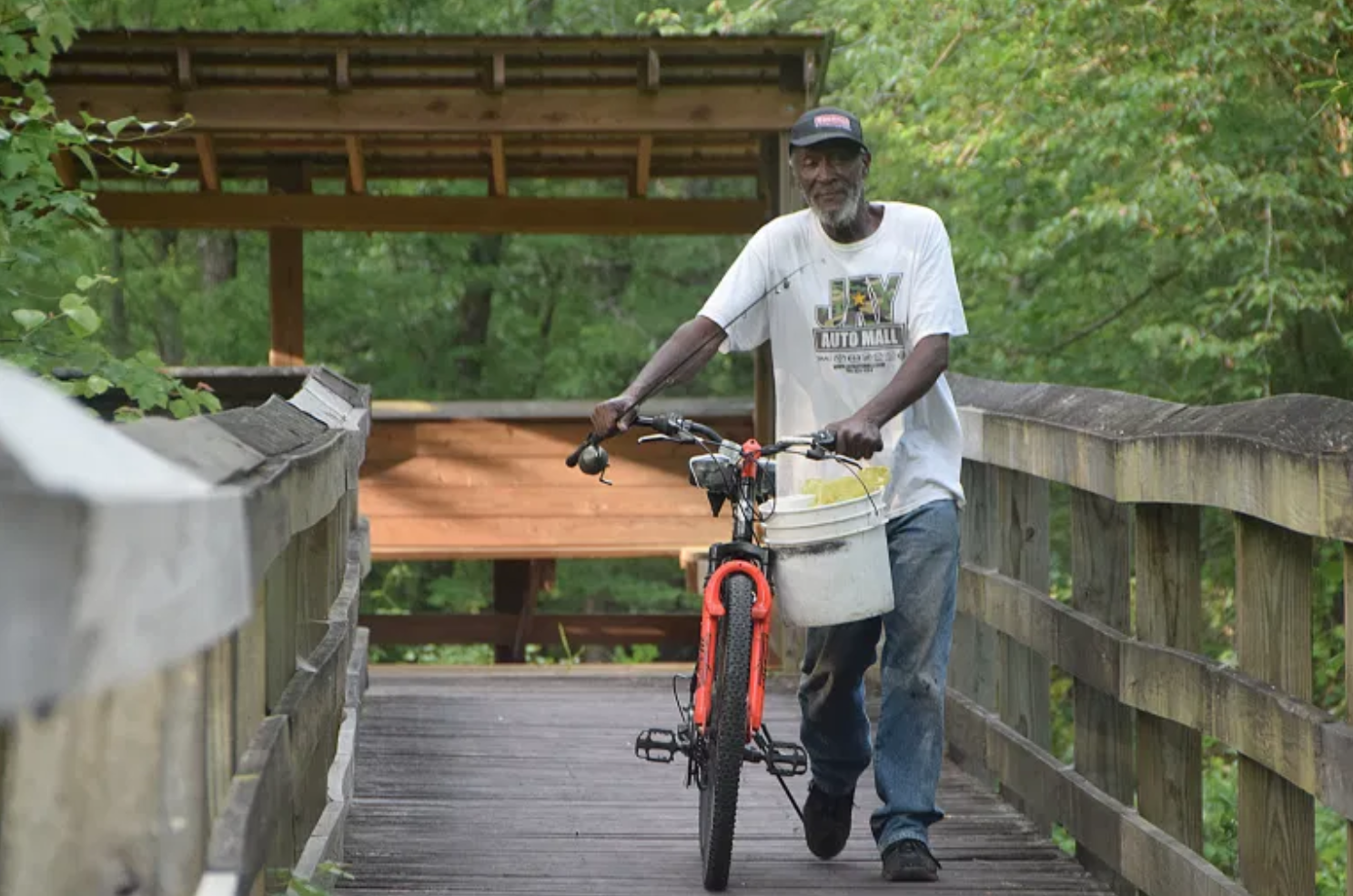
Michael Gore pushes his bicycle toward home after a successful day fishing on Red Belly Slough.
Gore chooses to fish by foot along Red Belly Slough or The Boon, both of which run close by the boardwalk.
Gore is one of 12 children reared by Mildred and Booker T. Gore. “I’m the only one who likes to fish,” he says with incredulity.
He has taught his five nephews to fish and to swim.
His cousin, Cubby Gore, described by Michael as in his 80s, was supposed to be with him on this temperate May afternoon, but Cubby has chosen to fish closer to the N.C. 904 bridge.
“One thing about Cubby,” Gore says matter of factly, “he does not like a snake.”
There happens to be one — a rather large water snake — resting on the edge of the river in a fallen tree branch.
Gore enjoys the River Walk in part because he was one of “nine or 10 guys” who helped build it. He remembers dragging timbers behind a riding lawn mower to the final section ending near The Boon.
Gore fishes “near about every day.” He’ll eat fish two to three times a week. “I was eating them every day at one time, but I had to stop.”
He mostly does odd jobs around town for money. His house flooded during hurricanes Matthew and Florence, but he never thought about leaving.
“Fair Bluff is one fine place,” he adds.
Earlier on this day, he had caught 10 fish and took them to a local convenience store. He gave them to a man who is too elderly to fish.
He feels at home at Red Belly Slough, named after the type of bream that frequent the narrow cut-through.
He throws the fish he’s caught back into the water. “They’ll be here tomorrow. You got to keep some in here.”
Gore reflects on his years of fishing. Red Belly Slough is his second home.“It’s cool, it’s quiet, and nobody bothers you,” Gore says before he leaves. “It’s about the only place in Fair Bluff you can get some good, quiet peace…because people are afraid of the snakes,” he adds with a hearty laugh.
Then his tone changes.
“You know,” he says with a sense of reverence, “you really can’t beat this place.”

Gore heads home over the railroad tracks at Fair Bluff. Chances are he’ll be back tomorrow.
This is the first in a series of three stories about the lower section of the Lumber River and the revitalization of Fair Bluff. A future series will feature the upper Lumber River.
On any given weekend in the southern mountains of Virginia, hundreds – sometimes thousands – of cyclists pedal the 17 miles from near the peak of Mount Rogers to Damascus, Va. It’s almost all downhill as the 1,700-foot descent winds along an abandoned paved or hardened rail bed that’s transected by wooden bridges spanning Laurel Creek.
A second stretch runs from Damascus on mostly flat ground to Abington, Va., completing the 35-mile trail.
Damascus, once barely clinging to life after the closure of its main industry in 1986, now thrives as cyclists and hikers crowd restaurants and stores almost year-round.
Two hundred and eighty-nine miles to the southeast lies Fair Bluff in Columbus County. Ravaged by floodwaters from the Lumber River following hurricanes Matthew and Florence, downtown is devoid of the throngs of people who once filled the streets during tobacco market. The crumbling historic brick buildings sit empty. The town clock on Main Street no longer tells the time, stuck on 11:30.
It is a tale of two towns, one of opportunity fulfilled, the other still looking for a new identity.
Thirty-four years ago, people in and around Abington and Damascus and a U.S. congressman representing the district had a vision for a transformational project that would capitalize on the growing number of cyclists and ecotourists coming from the cities looking for adventure. The railroad abandoned the line in 1977. Congress later appropriated $2 million to turn the railbed into a greenway. The result was the Virginia Creeper Trail, which opened in 1989 and is now visited by approximately 250,000 people annually.
Fair Bluff finds itself at a crossroads similar to that faced by Damascus in the mid 80s, which begs the question: Can the river that devastated the town twice in three years transform itself into a destination that will draw paddlers and other ecotourists from far and wide?
•••
Though it’s unlikely that hundreds of paddlers would take to the river on any given day, the pieces are in place to make Fair Bluff an ecotourism destination.
Lumber River State Park Superintendent Lane Garner believes the river and state park will grow as more people seek solace in the great outdoors.
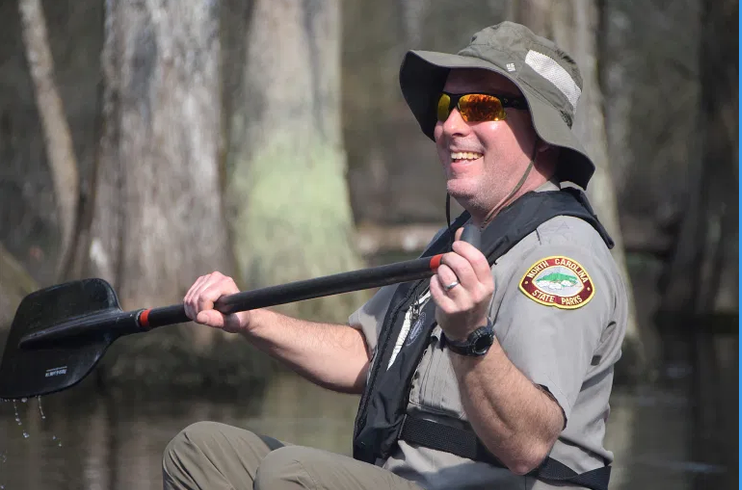
Lane Garner, superintendent of Lumber River State Park. Photo by Les High
“We like to say we are in the forever business,” Garner says, “meaning we manage properties that will be protected forever. I hope to see more property protected through various agencies and conservation groups like the Lumber River Conservancy or private citizens that realize the importance of being good stewards to the environment.
“I also hope to see more recreation opportunities offered at the park with additional trails, both hiking and equestrian, camping opportunities like primitive and paddle-to sites, and RV sites. Recent floods have changed some of our plans because a majority of our land is in the floodplain, but with careful planning I hope to see additional facilities that can withstand future storms.”
Garner believes that as use of the river increases, the state park and Fair Bluff have the opportunity to grow with it. He envisions everything from private outfitters to a brewery and bed and breakfasts in Fair Bluff.
River Bend Outfitters
Richard Willis and the late Stacy King once ran an outfitting service on the river, operating for nine years from a small building at the boat landing in Fair Bluff.
King had a vision to promote Fair Bluff and its natural resources, Willis said. One result of that vision was River Bend Outfitters, founded in 1997. King, in his 70s at the time, owned canoes, kayaks, and other equipment, had an amiable demeanor, and “sought the best in people,” Willis said.
Willis, the younger of the two and in his 30s, did most of the guiding and heavy lifting of canoes and kayaks. He was working at a job out of state and looking for a way to get back to his hometown.
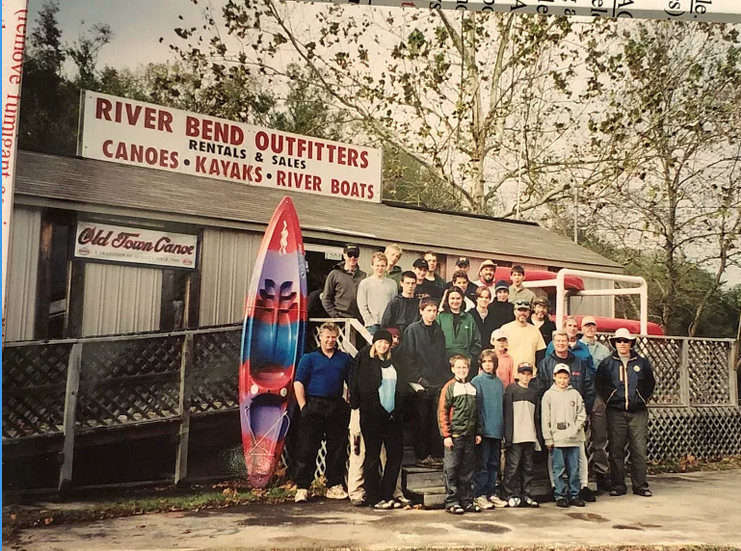
A group in front of River Bend Outfitters, which operated for nine years out of Fair Bluff by Stacy King and Richard Willis. Submitted photo by Richard Willis
Guiding people on the river was a natural fit for Willis.
“I loved the camaraderie and teaching people about the river and nature and all it has to offer,” he says.
River Bend had about 20 canoes and 20 kayaks. Most excursions were in the summer months.
“Some days we didn’t have enough canoes and kayaks and some days there would be a drought,” Willis says.
River Bend didn’t do many overnight trips because the Lumber River has little in the way of land adjacent to the water. Trips were mostly about four to six hours long, paddling from U.S. 74 to Fair Bluff, or three hours long, winding from Princess Ann to Fair Bluff.
Like everyone else who talks about the river, Willis notes that it can be dangerous, with varying degrees of water levels and velocity, snags or “strainers,” and sand bars. He generally required a guide for every seven boats.
There were the occasional incidents, including one couple who got into trouble and walked back to Fair Bluff after finding their way out of the swamp.
Willis believes another outfitter could make a go of it today. He says anyone getting into outfitting would probably need a supplemental income.
“It was mostly a weekend thing,” Willis says. “We had a lot of repeat customers. Now with all this traffic coming through town, who knows?”
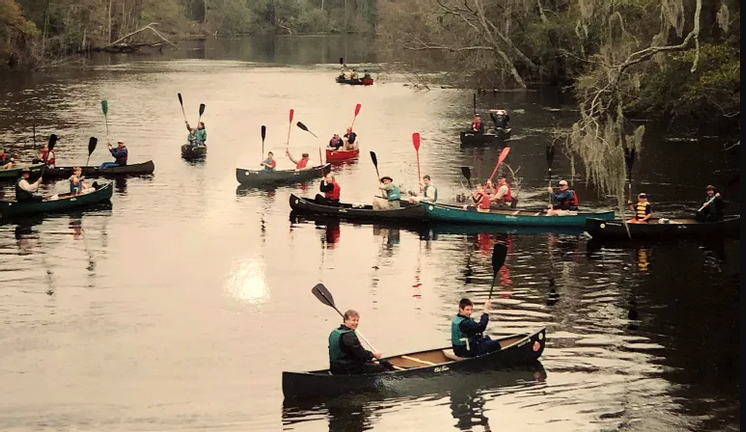
An early group in River Bend Outfitter canoes near the take-out point in Fair Bluff. Submitted photo by Richard Willis
The river has its pluses and minuses for outfitting. Its narrow width and sharp turns make it hazardous for canoes and kayaks to share the river with motor boats. There aren’t a lot of take-out spots for lunches unless the water is low and sandbars are exposed. He loathes the increased logging of old-growth trees that are felled to within only 50 feet of the river, leaving ugly scars that will last a generation.
“But,” Willis says, “guiding on the river brought a lot of joy and pleasure to me personally. It’s such a tranquil place.
“If we can keep it in pristine condition…,” he says, his voice trailing off. “People don’t realize just how precious the river is.”
Reimagining Fair Bluff
Town Manager Al Leonard has been instrumental in trying to rebuild Fair Bluff after the hurricanes.
“Every community has to find out what its niche is,” Leonard says. “Fair Bluff’s is the Lumber River. With the growth in Myrtle Beach and Brunswick County, we want to align ourselves with what’s coming.”
Riverside Drive, Leonard notes, is full of pickup trucks during the warm months without much marketing or promotion. “It’s a really good place to spend a Saturday or Sunday with friends or family.”
The Columbus County commissioners, including Commissioner Randy Britt of Fair Bluff, funded a short section of the Fair Bluff River Walk, a winding, elevated wooden walkway that is adjacent to the Lumber River. It could easily be southeast North Carolina’s most beautiful trail.
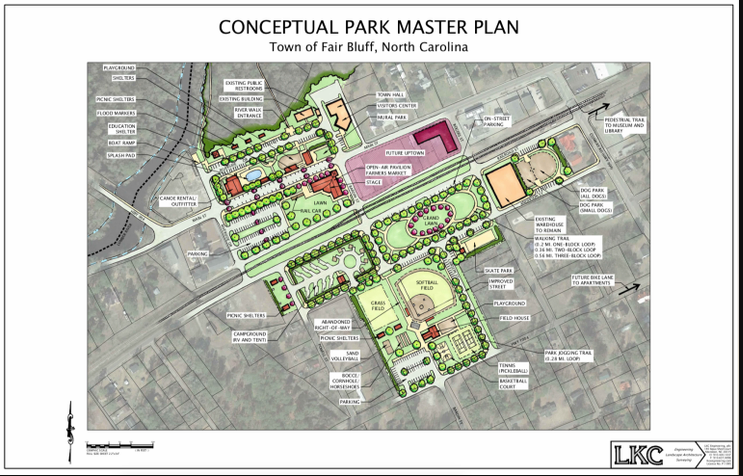
A proposed master plan for the new Fair Bluff park where downtown is currently sited.
Town Commissioner Willard Small and Leonard were members of the state’s Tobacco Trust Fund board and later secured a $450,000 grant to extend the boardwalk to three-quarters of a mile.
After repairing water and sewer infrastructure and moving the town hall and fire department to new facilities, Leonard and town commissioners began to work on Phase II of the recovery — aligning the economic future of Fair Bluff with the river.
A photograph taken after Hurricane Matthew shows a fiberglass ski boat navigating down Main Street with ease. The dirty water didn’t recede for days. Mold and mildew spread like wildfire inside businesses. The water eroded the old brick, rendering many buildings structurally unsound.
The future of the nearly bankrupt river town was, as Leonard once put it, “bleak.” Many residents left, shrinking the population from more than 900 to about 625.
But Fair Bluff has found a spark.
Trail Life Troop 1533 boys and leaders launch a canoe at Princess Ann landing. Photo by Les High
The River Walk remains. The town recently cut the ribbon on a new housing complex and received funding to build a new business district outside the flood zone.
Fair Bluff hopes to secure an N.C. Parks and Recreation Trust Fund matching grant that will create a park with campsites, a farmer’s market, open spaces with a pavilion, and recreational fields and courts, among other features where downtown now sits.
The trick, Leonard says, will be finding money to tear down the existing buildings to make way for a new Fair Bluff that would come to rely on the very waters that nearly destroyed it.
Small supports the plan to convert downtown Fair Bluff into a destination for people looking for the same sense of nature he’s enjoyed for his 96 years.
“The people here are friendly and the river is just beautiful,” he says. “I believe Fair Bluff will come back even better than before.”
An old school bus probably served as a fishing cabin back in the day. Photo by Les High
Economic development tool
Development can conflict with the environment, but the economic development directors in Columbus and Robeson counties, Gary Lanier and Channing Jones respectively, believe the river can spur green economic growth and jobs.
“The potential for ecotourism with the Lumber River is immeasurable,” Lanier said, noting that the Lumber has been designated one of North Carolina’s five “Wild and Scenic Rivers.”
“As an avid kayaker myself, I have spent many enjoyable hours on the Lumber River. There is a constant current in the river that allows you to sit back in your boat and just admire the wildlife while you drift down the river.”
Having more outfitters would be a benefit to ecotourism growth, Lanier says.
“For the less athletic among us, a touring pontoon boat would let a lot of tourists enjoy the river, especially those who may not be able to canoe or kayak. I would love to see anything that will enable more people to see what a wonderful natural asset we have.”
Lanier would like to see funding for a river tourism master plan in conjunction with the state park.
Jones said efforts to clear the river of debris have greatly increased the possibility of the Lumber River becoming a paddling destination.
“The ecotourism sector is something that really needs to be evaluated and looked at as a prospect,” Jones says. “It has the possibility of increasing dramatically because of the resources and funding that have come to the county to clean out the river. The accessibility of individuals who want to take scenic tours has tremendously changed. They have the ability to go in there and navigate the river in a way that hasn’t been done in years.”
‘Very high water quality,’ but for how long?
Though stained dark brown with tannins like most coastal rivers, the Lumber is remarkably clean, says Joseph White, a biology professor at the University of North Carolina-Pembroke.
White grew up near the Catawba River in the foothills of North Carolina.
“The Catawba and its tributaries are just as charming and beautiful as the Lumber, but very different,” White says. “Many of the Catawba’s tributaries start as rocky, fast-moving mountain streams surrounded by rhododendron and mountain laurel. The larger streams and rivers they merge to create are often disturbed by channelization, impoundments, development in the riparian zone, pollution, and the like.
High water covers the dock at the N.C. Wildlife Resources Commission landing in Fair Bluff. Even though the water is dark with tannins, the Lumber River is remarkably clean. Water quality will be a key for ecotourism in the future. Photo by Les High
“It’s pretty special to have a major river like the Lumber that, at least to the naked eye, is in pristine condition. The fact that there are no dams, limited development on the river, and that water quality remains high, even with all of the activity going on in the watershed and the recent storms, really speaks to the gem the Lumber really is. Then add to that the bald cypress and Spanish moss, the swamps and wetlands…it really is a captivating place.”
White cautions that local and state governments must be diligent about protecting the river and the areas that surround it.
“Counties and municipalities can benefit from developing parks and features like the Fair Bluff River Walk and incentivizing new businesses that will foster and benefit from ecotourism,” White says. “However, I would urge counties to limit disturbance in the river’s floodplain or adjacent terraces, and that these developments have as small a footprint as possible. Fragmentation of the forests along the river will reduce the benefits of preserving the river.”
The greatest threats to the Lumber are pollution and the degradation of its high water quality, White says.
“Being in a rural area that is heavily farmed and with significant livestock operations, pollution should be a significant concern. This is pollution that washes into the river from fields, yards, and parking lots during rain events. It also includes things like fertilizers and pesticides as well as oil and grease, sediment from erosion on the uplands, and bacteria from pet or livestock wastes. The higher the abundance and concentration of these pollutants…the more concerning this threat becomes.”
The partnership with the conservancy permits UNCP students and faculty the use of protected properties for academic and research purposes.
“I think about how much the residents of the area and those who grew up here love and care about the river,” White adds. “I have the privilege of working with a few Lumbee folks, and to hear about the importance of the river in their history and culture is really moving.”
By: Thomas Sherrill, The News Reporter
Years after graduating from Southeastern Community College, Pamela Young Jacobs returned to campus this month in a position designed to help small businesses thrive.
“I started my journey at SCC years ago as a student. It feels great to be back on campus. The environment is so conducive to the personal success of our students and campus community,” Jacobs said. “I love the fact that I have the opportunity to build a legacy at SCC in helping students and small businesses succeed. I am so honored and proud to be a member of the Rams family.”
“SCC is excited to have Ms. Jacobs join the staff as the new Director of the Small Business Center. The center is a great resource for our community,” said SCC spokesperson Haylee Damato.
Jacobs, who is chair of the Waccamaw Siouan Tribe and a former county school board candidate, has worked in small business and economic development most of her life in Columbus County.

Pamela Young Jacobs, Director of the Small Business Center at SCC
“I began my journey into the small business world around 13 years old. My father owned a small landscaping business and my job was to keep payroll by hand on a very large ledger. I learned the importance of hard work, early mornings, managing projects, hiring employees and a strong work ethic,” Jacobs said.
Jacobs said her dad only had an eighth-grade education, so she became an integral part of the company’s growth.
“Over the years his business grew from a small landscaping company to a multimillion-dollar corporation and the first 8(a) company in the area,” Jacobs said. “His reputation for good work was impeccable.”
According to the U.S. Department of Commerce, 8(a) companies are small businesses with at least 51% ownership and control by “socially and economically disadvantaged individuals” that qualify for assistance from a business development program within the Small Business Administration.
Pamela Young Jacobs’ proudest business achievements came after her father died in 2001, when she won her first contract — a five-year, $10 million contract at Charleston Air Force Base — followed by winning an economic development award for helping other small businesses succeed.
“Everything I learned from business conception to expansion came full circle on that day, and it became my goal to help others achieve the success that our company was afforded,” Jacobs said.
Jacobs earned an associate degree in business and finance from SCC and a bachelor’s from UNC Pembroke. In addition to serving in various roles on the Waccamaw Siouan Tribal Council, Jacobs has been a high school coach and an advisory council member for East Columbus High School. She worked multiple years in healthcare and youth services. Jacobs most recently served as director of health information technology at Signet Healthcare and the owner of Songbird Enterprise.
When the small business director position at SCC became available, Jacobs saw a way to go back to her roots in more ways than one.
“There are two passions in my life, the success of students and the success of small businesses. When the position at Southeastern presented itself, I felt that it was the perfect fit for who I am and the perfect opportunity to help others succeed,” Jacobs said. “I realized that this was an opportunity to not only put my degrees to work but the knowledge that I have acquired throughout my life.”
Jacobs, who started in her new position May 3, said she’s excited to build bridges to the community.
“Small business owners are some of the most hard-working individuals you will find because their livelihoods are based upon the success of their company. My goal is to help our small business owners achieve that success,” Jacobs said.
She explained that her short-term goals include reconnecting with businesses “because the college has not had a full-time director in some time.
“COVID-19 has taken a toll on so many individuals. My goal is to contact our small businesses, do an assessment and share what the Small Business Center can do to offer recovery assistance. Along with our core webinars that the college offers, I plan to offer customized seminars according to specific business needs,” Jacobs said.
By: Thomas Sherrill, The News Reporter
The roughly half-century-old terminal building at Columbus County Municipal Airport could be making way for a modern, bigger building constructed using federal funds.
A new hangar is also in the works after the Columbus County Board of Commissioners approved airport improvements using $3.2 million of the $10.7 million earmarked for county government by the American Rescue Plan.
County Manager Eddie Madden said a strategic planning team made up of staff members from different county departments developed a list of unmet capital projects that didn’t have a dedicated funding stream.
“The airport projects, in particular, have been on the county’s capital improvement list for some time,” Madden said. “Furthermore, the terminal building project and the corporate hangar project seem to meet the requirements for the ARP program and would be a good use of the funds. Otherwise, the two airport projects would be many years down the road from being constructed.”

Phil Edwards is director of Columbus County Municipal Airport.
For airport director Phil Edwards, the projects are a long time coming, although he remains cautious about the funds arriving.
“We have been planning this for several years, and hopefully we can get the money to do it,” Edwards said. “You never know how that goes.”
Madden said he’s been notified that the county should receive the first half of the $10.7 million “before the end of May” and that “the remaining amount will be received within one year.”
Playing catch-up
The county has designated that $2 million of the designated airport funds would be for a new terminal building. Edwards says the current terminal, which he believes was originally built in the late ’60s or early ’70s, doesn’t meet modern state standards for an airport such as Columbus.
“We’ve had leaking problems and water problems inside with the plumbing,” Edwards said. “It needs to be bigger.”
A new hangar, Edwards said, would be a corporate hangar, which he believes can help attract new businesses.
“And if you’re not keeping a big corporate plane, you can keep several smaller planes in there, so there’s a benefit both ways,” Edwards said.
As a gateway to Columbus County, Edwards believes in the airport’s use as an economic driver.
The N.C. Department of Transportation’s Division of Aviation annual study released in January credits Columbus County Municipal with $167.09 million in annual economic output, $31.42 million in personal income and $20.511 million in state and local taxes, accounting for 515 jobs. Those figures were some of the highest economic outputs for a general aviation airport in the state.
Edwards believes the upgrades will help Columbus keep up with neighboring counties, pointing to recent airport projects in Lumberton, Elizabethtown, Duplin County and Brunswick County.
“If you look around, we’re playing catch-up at our airport,” Edwards said.
The county airport has seen some improvements in recent years, Edwards said, which could help give it a boost, noting recent land purchases to clear one end of the runway and plans to do so at the other, making it safer for planes to land and take off.
Emergency prep
Madden brought airport experience when he left his role at Elizabethtown town manager earlier this year to become Columbus County manager. In his former position, Madden helped establish a new terminal at Curtis L. Brown Jr. Field, the airport in Elizabethtown.
“I do respect Eddie’s input and his recommendations at the airport,” Edwards said. He did a great job at Elizabethtown, and I’ve known him for several years. He is interested in this economic development.”
Both Madden and Edwards said that the upgrades will not only benefit economic development but will also better prepare the county for emergencies.
“During a hurricane or natural disaster, the airport is used a lot,” Edwards said, explaining that during Hurricane Florence in 2018, the airport was the only way supplies could be delivered due to roads being flooded.
The numbers
Another revenue stream helped by the improvements is fuel sales, Edwards said.
According to budget data, the county expects an end-of-fiscal-year boost in airport revenues.
The county had reported $167,485 in fuel sales as of Feb. 11, when 2020-21 budget data were put together. For the remainder of the fiscal year, from Feb. 12 to June 30, the county projects estimated fuel sales will be $279,277, meaning a total of $446,762.
In 2019-20, the Columbus County Airport reported $405,610 in fuel sales.
The county expects tie-down rentals (when pilots rent spaces to store planes) to be down slightly from $42,424 in 2019-20 to $38,500 in 2020-21.
On the other side of the budget, the county expects $644,979 in 2020-21 airport expenditures, up from the $620,804 in 2019-20. Most of those costs are for fuel.
Seventy-five students graduated from Columbus Career and College Academy in the West Columbus High School auditorium Tuesday night. Jennifer Collins recognized awards and honors for each student. Rod Lykens gave the commencement address, while Christian Norton gave the student commencement address. CCCA Principal Jeremiah Johnson presented diplomas to each graduate with the assistance of school counselor Kayla Gooden and math teacher Nicky Hobbs.

Southeastern Community College held its spring commencement exercises Friday morning in front of the A-Building on the college’s campus. Friends and family members were able to drive in front of the stage to watch more than 140 graduates walk across to receive their degrees.

2021 SCC graduation ceremony
By: Thomas Sherrill, The News Reporter
Construction travel and campgrounds helped Columbus County fare better than many other locations in North Carolina in terms of visitor spending in 2020, Columbus Chamber of Commerce and Tourism President Jennifer Holcomb said last week.
Visitor spending in the state dropped 32% last year, according to the U.S. Travel Association and Tourism Economics. Columbus County’s impact numbers won’t be fully known until August, but Holcomb said the county was affected far less than many areas.
“We fared much better than many places in the state, especially because the majority of our occupancy is not leisure travel-related,” Holcomb said.
According to preliminary figures released by the Economic Development Partnership of North Carolina, visitors to the state generated $3 billion in federal, state and local taxes in 2020, a 26.6% decrease from the year before, and direct tourism payroll decreased 24.5% to $6.4 billion.
The most affected times in Columbus County during 2020 were early in the pandemic, going from March to June, Holcomb said.
“It affected us at the beginning of the summer season, but not to the degree that major destinations have felt,” Holcomb said. “Because of our remote area, some of our properties did very well, like our campgrounds, which are a fabulous way to get away from crowds and COVID-19.”
Holcomb said that Columbus County has natural assets, such as sailing and kayaking, that are popular during a pandemic.
“Our rural nature lends itself very well to recruiting the weekenders and vacationers,” Holcomb explained.
Construction travel also helped the numbers, with Holcomb mentioning the BB&T office construction and NCDOT projects, which continued during 2020.
Tourism dollars are beneficial for Columbus because, as Holcomb stated, visitors don’t burden local tax-funded resources.
“We love relocators and retirees, but those revenue generators put a drain on our resources. Tourists come; spend their money and leave. We’re proud of those dollars. Those dollars are used to support the economy, retail and service businesses,” Holcomb said.

Construction travel and campgrounds helped Columbus County fare better than many other locations in North Carolina in terms of visitor spending in 2020.
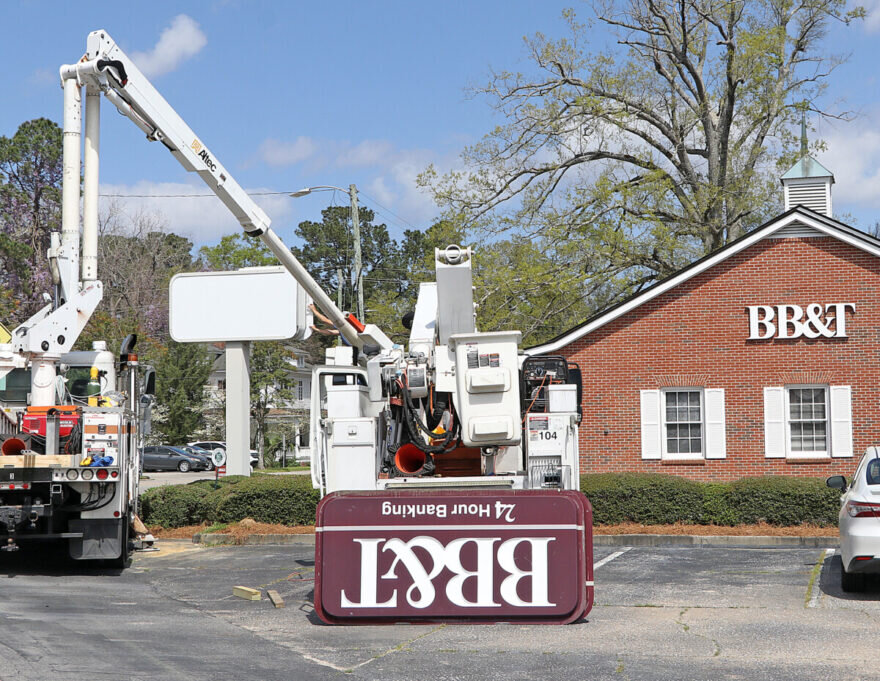
Crews removed the BB&T sign from the bank’s Courthouse Square branch March 30. The branch consolidated with BB&T’s other local operations into a new facility on J.K. Powell Boulevard. Photo by Justin Smith
By: The News Reporter
In a unanimous vote Monday night May 3, the Columbus County Commissioners approved a second purchase from BB&T in recent months, this time obtaining the former Courthouse Square branch as well as the adjacent land owned by Don and Deborah Viets.
The sales were for a combined $660,000 — $600,000 to BB&T and $60,000 for the Viets property.
“I think it’s a purchase of some property that could be very vital to the county, being adjacent to the [Historic] Courthouse in the circle that some of the business is being done in,” Board Chair Ricky Bullard said after the meeting. “The building has a lot of potential for county offices, especially the drive-through.”
Bullard said that the county water department could potentially use the drive-through for customers paying their bills.
After the vote, County Manager Eddie Madden said that the county is in the process of evaluating the property, but has an idea on how to use it.
“It’ll be used for county purposes. We will likely move some county offices to the facility,” Madden said.
According to county land records, BB&T owns six small tracts of land in the block, all under one acre each. The largest tract contains the former BB&T building itself. The combined tax value for the six lots — including the building — is $723,000.
The Viets property, an adjacent vacant commercial lot that is also less than an acre, has a tax value of $103,100, according to county records.
Monday’s board agenda did not include the purchase. The commissioners’ vote came at the end of the meeting following a closed session.
Less than a month ago, on April 5, the board approved purchasing the 10.49-acre North Whiteville BB&T campus for $1.25 million. Madden previously said that the county plans to put some offices there, and perhaps a county garage. Economic Development Director Gary Lanier said in March that the county could potentially use a portion of the North Campus as a business incubator.
BB&T moved into its new 100,000-square-foot facility along J.K. Powell Boulevard last month, closing all its other local locations in North Whiteville, Courthouse Square and along South Madison Street.
COVID-19 cases in tax office
Two confirmed COVID-19 cases among staffers in the Columbus County Tax Administration Office has led to 10 total staffers being quarantined Madden said during the meeting.
“Some functions of the office could be temporarily affected but the director and staff are making the necessary adjustments to keep the office functioning,” Madden told the board.
Madden said he found out that the positive cases were confirmed Monday afternoon.
Elsewhere in the meeting, the board voted 6-1 to limit commissioner comments at the end of regular meetings to three minutes each, with Commissioners Giles “Buddy” Byrd voting against.
The motion said that the move would align the commissioners’ comments with those of the general public, which are restricted to three minutes.
In his opposition, Byrd said that members of the public often only speak about one subject but commissioners might have more items that they need to discuss.
“I oppose it, but that’s OK. I can be one of seven,” Byrd said.
County Attorney Amanda Prince kept time during commissioners’ comments later in the meeting.

A customer enters the new BB&T on J.K. Powell Boulevard in Whiteville. Staff photo by Justin Smith
By: The News Reporter
The Cape Fear chapter of Commercial Real Estate Women (CREW) honored BB&T’s new facility in Whiteville last week with its Economic and Community Enhancement Award.
The awards given in various categories are meant to “recognize excellence and leadership in commercial real estate” in the region, according to a news release.
“Having occupied aging facilities in Whiteville since the 1960s, BB&T now Truist reached a crossroads on renovating their existing space or starting over,” CREW noted. “Realizing the best solution was to build a new facility, Truist broke ground on a 101,000 square foot facility along J.K. Powell Boulevard. With over 500 employees in the Whiteville community, the bank wanted its new workplace to support and be an integral part of the Whiteville community.”
The news release noted that the BB&T building features “state of the art work areas, broader health service amenities with fresh food options and a health clinic and fitness center on site, critical to attracting and retaining teammates.”
BB&T’s Phil Marion and Evan Gore were on hand Thursday at the Wilmington Convention Center to accept the award.
More than 30 employers from a variety of industry sectors are participating in a hiring event today (Tuesday) at Southeastern Community College. Job seekers are invited to meet with business representatives until 7 p.m. in T-Building. The event is sponsored by the NCWorks Career Center, Southeastern Community College and the Columbus Chamber of Commerce and Tourism.
Job seekers should be prepared to fill out applications and participate in short on-site interviews.
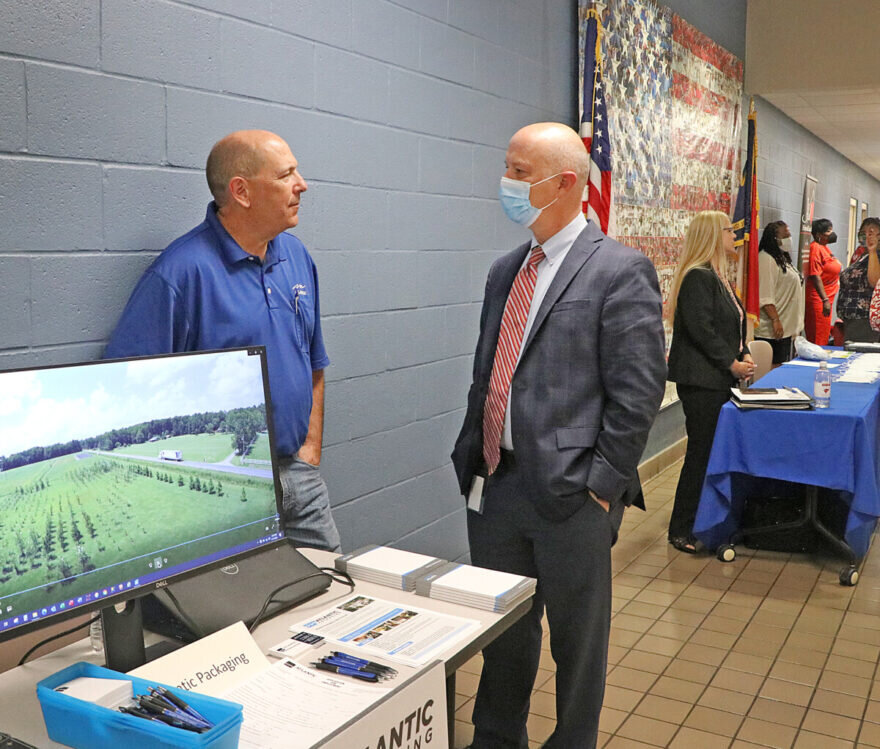
Columbus County Manager Eddie Madden talks with a representative from Atlantic Packaging.
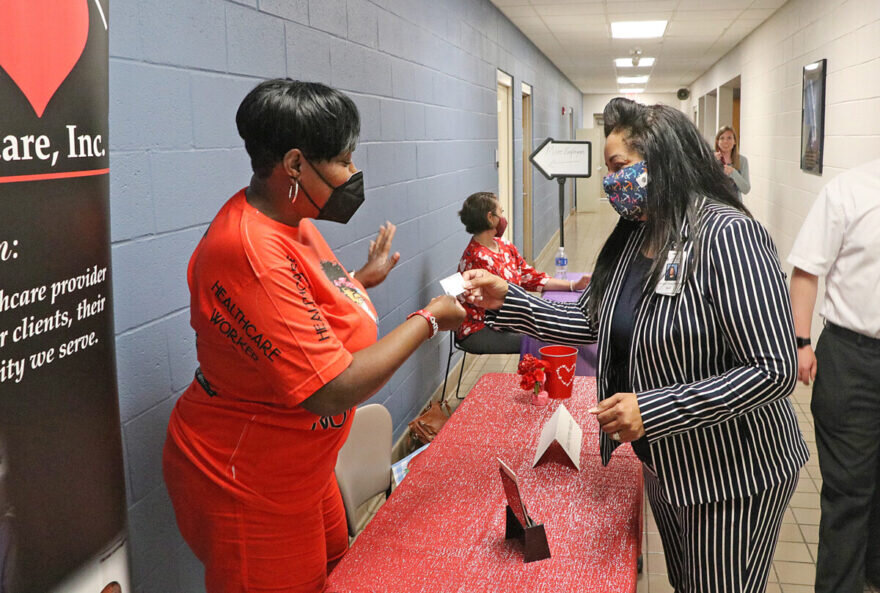
Frankye Boone-Newkirk of Allied Home Healthcare talks with Pamela Young Jacobs, director of the Small Business Center at Southeastern Community College.
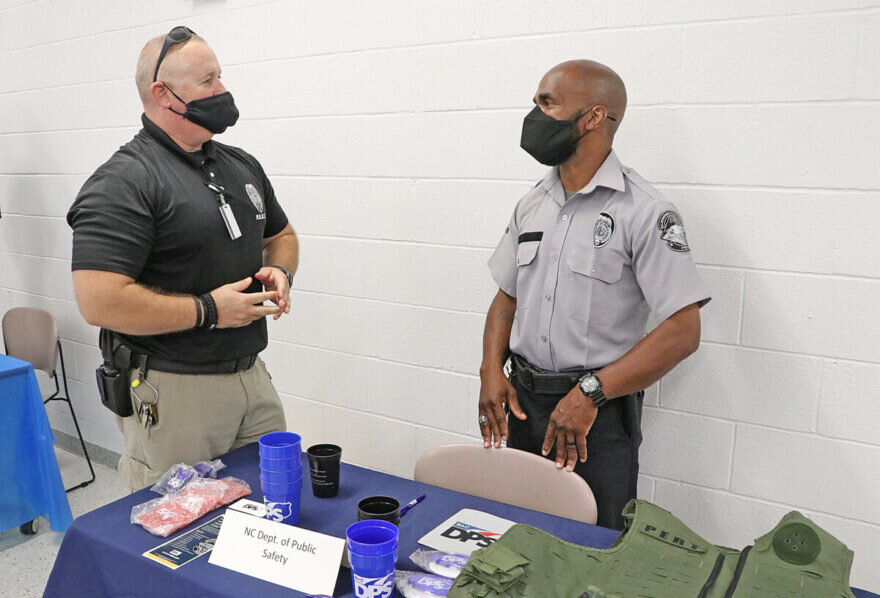
Representatives from the N.C. Department of Public Safety staff their booth.

Engineer Bill Lester designed this layout for the 21.7-acre park with input from Fair Bluff residents and assistance from council members Kathy Ashley and Clarice Faison.
By: Diana Matthews, The News Reporter
Fair Bluff residents and visitors could be playing pickleball, shooting baskets, exercising their dogs and listening to music in what was formerly the river town’s business district if a state grant comes through to build a park envisioned by town leaders.
Fair Bluff’s town council unanimously approved plans April 5 for a 21.7-acre park, then voted to submit those plans to the state with a grant application.
Amenities
One side of the design, prepared by engineer Bill Lester of LKC Engineering in Aberdeen, incorporates picnic shelters, gathering places and an openair pavilion/farmers’ market between the Lumber River and Main Street. There will still be riverwalk and boat ramp access. The park will butt up against a to-be-constructed new business district, Lester said.
Along the other side of the railroad tracks, Lester included spaces for active recreation,
including softball, volleyball, tennis, bocce, horseshoes, skating, camping, jogging and walking. The plan has two separate dog play areas: one for small dogs and another for dogs of all sizes. Lester designed the park’s amenities to accommodate community members’ suggestions. Council members Kathy Ashley and Clarice Faison worked closely with Lester since last fall to help form the plan.
Columbus County Cooperative Extension Director Dalton Dockery attended last week’s meeting and said afterward that he believes the proposed farmers’ market “will help the Fair Bluff economy and be a drawing card for local farmers to become more involved.” He said Extension may be able to help organize the market.
‘A long way to go’
Armed with the detailed drawings, the town will once again ask the N.C. Parks and Recreation Trust Fund (PARTF) for money to purchase and demolish about 40 flooddamaged properties to make way for the park.
A year ago Fair Bluff asked PARTF for $497,000. The state agency said the town needed to include a plan showing how it would reuse the space and how it would budget the grant money. Lester’s plan supplies both those requirements, Town Consultant Al Leonard said.
Leonard summarized council members’ hopes this way: “Fair Bluff’s recovery is going to take many, many more years. Acquiring the properties is only the first step toward creating a riverside park where downtown now stands. We have a long way to go, but we’ll go nowhere until we get ownership of those properties.”
The town will have Raleigh consultant David Hartigan complete the grant application and send it, along with the park plan, to PARTF in May. The state agency will announce its decision in October. If the town receives the $500,000 it is now asking for, it will match it using money previously allocated by the General Assembly for hurricane recovery.
Lester said it would be unfair to estimate completion time for the park project since funding will occur in phases, and some phases could take up to 24 months to complete. Environmental clearance, abatement and demolition would precede construction phases.
Part of overall recovery plan
“The hardest step in anything is the first step,” Leonard said. The next step will be up to state decision-makers.
The parkland project is part of a long-term hurricane recovery program, with $6 million already allocated by the General Assembly thanks to the 2019 Disaster Recovery Act.
Rep. Brenden Jones, Sen. Danny Britt and Sen. Bill Rabon all played a role in getting the $6 million for Fair Bluff appropriated by the legislature, Leonard said.
The 2019 recovery package included sums for canal dredging, street paving, other infrastructure, professional services, equipment and vehicles along with property acquisition in other areas of town.
Leonard said the legislators included $500,000 for parkland acquisition, and that is the sum Fair Bluff will use to match the PARTF grant if approved. Until then, that portion of the town’s recovery money “is sitting in the state treasury in Raleigh,” Leonard said.
All members of the council were present in person for the meeting. The agenda also included accountant Wade Greene’s presentation of the 20192020 audit, a report on occupancy and cash flow at River Bluff Pointe Apartments and routine monthly financial and police reports. Information about those items will appear in an upcoming edition of The News Reporter.
By: Thomas Sherrill, The News Reporter
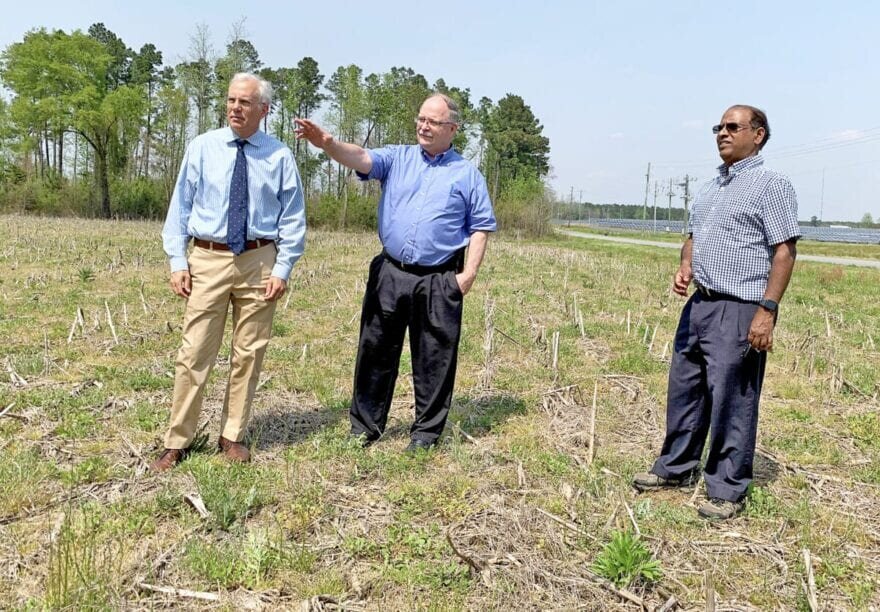
Gary Lanier, director of the Columbus County Economic Development Commission, talks to Jay Memula, right, of Jay Technologies about the future layout of a facility where soils will be mixed with specialty additives in the agri-business and horticulture industry. At left is Les High, chair of the Columbus Jobs Foundation, which owns the industrial park.
Raleigh-based agricultural businessman Sadanand “Jay” Memula has purchased a 30-acre tract of land in the Southeastern Regional Industrial Park with a multi-year plan to build a center for the manufacture of soil additives for horticultural products.
“It means jobs,” Columbus County Economic Development Director Gary Lanier said, adding that the company is a good fit with the local agricultural heritage and existing economy.
“This is the first sale of property for a new business we’ve had at the park since 2013, when MaxPro window tinting bought the Committee of 100 shell building,” said Columbus Jobs Foundation Chair Les High, who is also The News Reporter’s publisher. “With Memula’s unique business plan based on extensive experience, High said, “we believe the company is poised for growth.”
For Memula, the decision to go into business in Columbus County was a long time coming.
“The line was always a moving target,” Memula said, who recounts his conversations with Lanier going back several years. “I was contacting the different regions because of proximity to Wilmington and Charleston [S.C.]”
“It’s similar to many economic development projects, that they just sometimes take time for everything to come together,” Lanier said.
The purchase is part of a long-term plan that includes an operational facility at the old Fair Bluff Armory. In Fair Bluff, Jay Technologies is manufacturing bacteria-killing materials that go into hand sanitizers and cleaning agents.
“He really needed a building he could start up in, and we were able to find out the armory building in Fair Bluff was on a state surplus list and help get him in contact with the right folks to be able to purchase that building,” Lanier said. The Fair Bluff space gives Memula both office and lab space.
Eventually, the plan is to have research and development at the future Southeastern Regional Industrial Park facility, then move into manufacturing “in two to three years,” Memula said.
The sale of the 30-acre tract finalized last week, Memula said. Financial details of the property sale were not immediately available.
“We are trying to clear the land first, probably in the next six months,” Memula said.
Memula said he will make his agricultural soil additives to sell directly to large farmers. Lanier called Memula one of the smartest men he’s ever met and noted his extensive background in horticulture.
“If he starts a business up and starts to get some good traction, there’s no telling how far he can take a business,” Lanier said.
Initially, Memula plans on adding at least 10–12 jobs in Fair Bluff, then hiring additional workers once in a completed Industrial Park facility.
“As far as jobs, we have to review all the details,” Memula said.
“Hopefully he’ll get to be a big success, because the more product he can sell, the more people he’s going to need to hire,” Lanier said.
Memula could have chosen to establish Jay Technologies in Chatham County, where he owns land, Lanier said. But the economic developer credited his long-term relationship with Memula as the reason for landing the project in Columbus County.
Lanier said he will need to talk with the county commissioners about potentially providing an incentive package for Jay Technologies once more details about the company’s local investment are clear.
“I know our Economic Development Commission board has recommended that we move forward with an incentive package,” Lanier said.
“Incentives are always things that people are looking at, because it’s a big investment to establish a business and buy buildings and renovate buildings,” Lanier said. If neighboring states and counties offer incentives and Columbus County doesn’t do the same, he said, it makes economic development tough.
The Columbus County Commissioners are “extremely supportive” of economic development and job creation, Lanier said.
“They’ve told me many times, ‘We need the jobs; do what it takes,’” Lanier said.
By: The News Reporter

The Tabor City area expansion is the latest phase of ATMC’s “Faster Columbus” project.
ATMC continues its expansion of high-speed internet in Columbus County, announcing Tuesday that the service is now available in the New Life community east of Tabor City. In addition to internet with speeds of up to 1 Gigabit, residents there can also purchase telephone service, digital cable TV, home security and automation services from ATMC.
The Tabor City area expansion is the latest phase of ATMC’s “Faster Columbus” project, partially funded by a $7.9 million dollar grant awarded in December of 2019 through the United States Department of Agriculture’s (USDA) ReConnect Broadband Program.
As part of the project, ATMC is contributing an additional $7.9 million dollars in matching funds for a total project cost of $15.8 million. Upon completion of the project, ATMC will be able to provide high-speed internet service to more than 4,000 addresses in the rural Columbus County communities of Hallsboro, Lake Waccamaw and Bolton and in areas north of Tabor City and Whiteville. Construction is currently underway in the Hallsboro area with additional areas starting in the coming weeks. The entire project is scheduled to be completed by the end of next year.
“This USDA ReConnect Grant project is allowing us to expand our network to bring Columbus County’s fastest internet service to more people who desperately need it,” said Keith Holden, ATMC’s CEO and general manager. “Our commitment to serving Columbus County is real, and we can’t wait to show more people why our FOCUS fiber optics is Columbus County’s best internet service.”
Decade in Columbus
ATMC has served residents and businesses in Columbus County for more than a decade. In 2010, ATMC received a $12 million grant through the USDA to bring high-speed internet to over 2,600 residents and businesses in Nakina and Old Dock. Last July, the company announced the completion of a project made possible through a $1 million grant won in the 2019 NC GREAT Grant Program, which made high-speed internet available to 1,200 households in the Beaverdam community. And in the last few weeks, ATMC announced that service was being made available to businesses and residents in Fair Bluff.
In December, ATMC won additional grant funding through a supplementary round of the NC GREAT grant program, which will allow the expansion of high-speed internet service into the Boardman and Cerro Gordo communities, areas along Smyrna Road near Whiteville, and additional areas near East Arcadia, Riegelwood, Northwest and Sandy Creek. Upon completion of these projects, since 2011, ATMC will have invested more than $40 million in broadband projects that will improve and expand high-speed internet service in Columbus County.
Tabor City is the first area to have service available as part of ATMC’s USDA ReConnect project. As construction in these additional phases is completed, service will be made available. More information about ATMC’s progress to bring high-speed internet to Columbus County is available at www.fastercolumbus.com. Residents and businesses located in the first phases of Tabor City can sign up for services from ATMC service by calling 910-754-4311.
By: The News Reporter
The town of Fair Bluff is getting an economic boost as Gov. Roy Cooper announced Thursday that Texas-based polyethylene pipe maker Pipeline Plastics will spend $4.6 million in a production center that will employ 44 workers. The plant will be located in the former Ply Gem plant on U.S. 76.
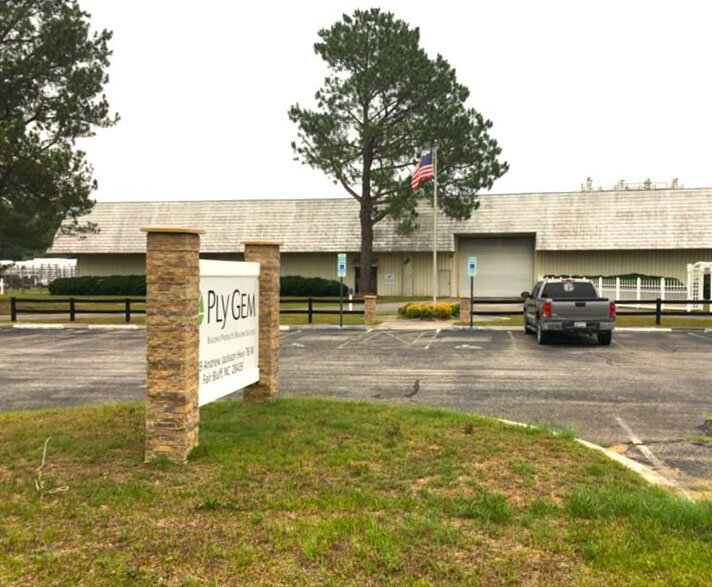
Pipeline Plastics will spend $4.6 million in a production center that will employ 44 workers. The plant will be located in the former Ply Gem plant on U.S. 76.
“I think it shows that Columbus County is an excellent destination” for companies that distribute manufacturing products for the southeastern U.S. and globally, said Joe Melvin, marketing director of North Carolina’s Southeast, a regional economic development marketing organization that helped attract Pipeline Plastics.
“To get a company into that vacant facility in Fair Bluff, which has been hit so hard by hurricanes and economic stagnation, I think it’ll be a really nice shot in the arm to that community,” said Steve Yost, president of North Carolina’s Southeast.
The Ply Gem plant has been closed since 2019, when parent company Cornerstone Building Brands announced it was moving production out of state.
Pipeline Plastics’ operation “will put some good jobs back into that community, bring people in who will buy gas, get a bite to eat and bring some cash flow into the town from the salaries,” said Columbus County Economic Development Director Gary Lanier.
Expansion plans
Along with the 44 jobs announced Thursday, Lanier said Pipeline Plastics will potentially hire more workers once the company installs additional extrusion lines. Cooper said that once the new jobs are in place, the area will benefit from a “nearly 1.6 million payroll impact in the community, each and every year.
“North Carolina’s appeal as a center for manufacturing continues to attract companies from many different industries,” Cooper said. “Our focus on building a well-trained workforce, combined with North Carolina’s outstanding transportation networks and East Coast market access, offers companies like Pipeline Plastics the right ingredients for success.”
The high-performance polyethylene pipe that Pipeline Plastics produces can be used for a variety of purposes, according to its website, “including drinking water, irrigation, mining, industrial, sewer and oil and gas gathering and distribution.”
“We are excited to bring our culture, reputation, and methodology as one of the safest, most sustainable and most efficient companies in the industry,” said Mike Leathers, president and chief operating officer of Pipeline Plastics after Cooper’s announcement. “This facility will not only create jobs and careers for this location but be a significant multiplier for the local economy, from jobs to suppliers and transportation.”
Railroad was a draw
Work to upfit the plant will begin this week, according to Lanier. He said that raw materials will be brought in on train cars through R.J. Corman Railroad Company and CSX Transportation, and the center will create pipes up to 65 inches wide.
“We are very pleased to be a partner of North Carolina’s Southeast, Columbus County Economic Development Commission and Pipeline Plastics,” said Todd Bivins, spokesperson for R.J. Corman. “When R. J. Corman restored railroad operations in the region in 2016, we expressed our commitment to providing exceptional rail service as a competitive freight transportation solution. It is rewarding to see how that commitment is a contributing factor to economic growth, particularly for this community today.”
The plant will run 24 hours a day, with 16 rail cars of raw materials arriving each week.
Melvin said the process of bringing in Pipeline Plastics started in October through a virtual meeting.
“The value proposition was so strong they came in within two weeks,” Melvin said. he explained that the former Ply Gem facility satisfied Pipeline Plastics’ very specific building requirements.
“The Columbus County Economic Development Commission [and] the town of Fair Bluff worked to put together an incentive project to modify a building to meet their needs,” Melvin said.
The project will receive a One North Carolina Fund performance-based grant worth $125,000, plus technical assistance from Duke Energy, and Lanier said that work is underway on a building reuse and restoration grant to offset some improvements to the facility. Lanier estimated the uplift costs to eventually exceed $900,000. Additionally, Southeastern Community College will provide workforce training, Melvin said.
“The OneNC Fund provides financial assistance to local governments to help attract economic investment and to create jobs. Companies receive no money up front and must meet job creation and capital investment targets to qualify for payment,” the Cooper announcement said.
Two announcements in a week
The news of Pipeline Plastics follows the economic development announcement of Contract Lumber, which opened a new facility that will soon be manufacturing floor joists and trusses alongside R.J. Corman Railroad on Georgia Pacific Road.
“We hoped to have several strong announcements as the pandemic eased and the economy picked up steam, so it’s good to see it happening with the second new jobs announcement in a week,” said Les High, chair of the Columbus County Jobs Foundation and publisher of The News Reporter. “The Ply Gem plant was a natural fit for a pipe manufacturing company, and our team put together a strong proposal. Like Contract Lumber, [Pipeline Plastics] will be a heavy user of R.J. Corman Railroad, which is another win. It’s an even greater bonus that this will help Fair Bluff.”
Yost said this is a reflection of an increase in manufacturing activity within the region.
“This type of company [is] wanting to be deeper in the market, where there is higher, stronger economic growth or projected growth,” Yost said. “That’s our mission, marketing this region nationally, globally.”
Lanier said he knows many people who used to work at the Ply Gem plant are interested in working there again. These former workers, Lanier said, now drive upwards of 45 minutes one way for work elsewhere.
“They’re super friendly people and it’s a great place to live,” Lanier said of Fair Bluff.
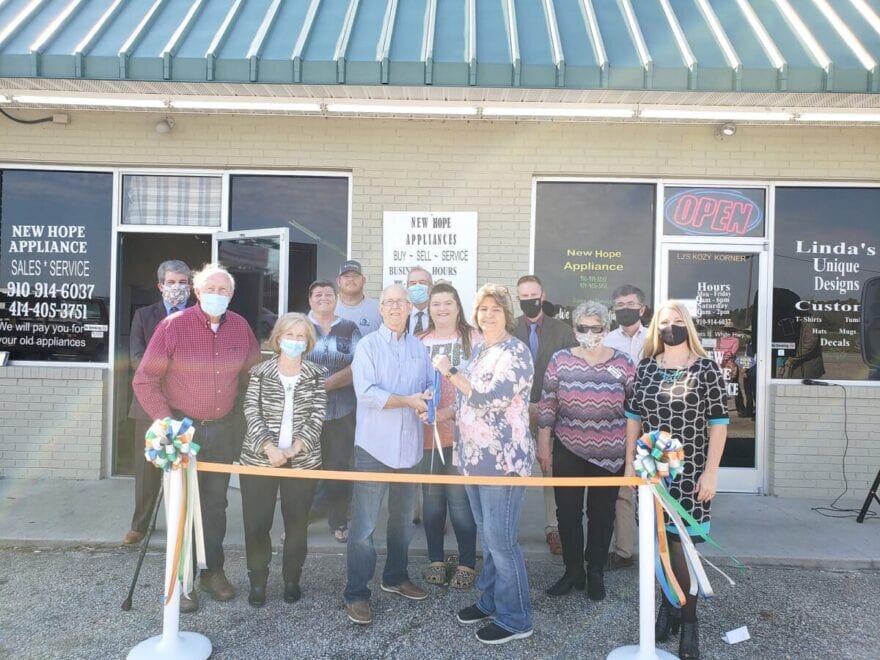
The Columbus Chamber of Commerce and Tourism hosted a ribbon cutting ceremony for New Hope Appliance on Feb. 25. The store is located behind the Time Saver gas station in New Hope, south of Whiteville.
By: Ivey Schofield, The News Reporter

Cook Out, with its burgers, hot dogs, barbeque and shakes, is moving into the former KFC building on J.K. Powell Boulevard, according to Whiteville Planning Director Robert Lewis.
Lewis received the site plans on Monday afternoon. “They have some comments to correct, but we are starting the process of plans review,” he said.
Cook Out, founded in 1989 in Greensboro, has locations across the South, including Alabama, Georgia, Kentucky, Tennessee, Virginia, West Virginia, Mississippi and Maryland, according to its website. There are over 100 locations in North Carolina, with three “coming soon” in Tarboro, Pembroke and Knightdale.
Its website does not list Whiteville, but plans are underway with Summey Engineering Associates, an Asheboro consulting and land planning agency, according to Lewis.
Cook Out will move into 615 N. JK Powell Blvd., according to Lewis. KFC vacated the facility after constructing a new building next door at the intersection of J.K. Powell Boulevard and Washington Street.
Cook Out and Summey Engineering Associates did not immediately respond to requests for comment Tuesday morning. See NRcolumbus.com and Friday’s edition of The News Reporter for additional coverage as available.